Password Manager For WHMCS
(→Other) |
(→Other) |
||
| (32 intermediate revisions by 4 users not shown) | |||
| Line 1: | Line 1: | ||
<meta name="keywords" content="password manager for whmcs, password manager configuration, whmcs password manager management, whmcs password manager installation, whmcs password manager common problems, about whmcs password manager, whmcs password manager documentation, whmcs password manager faq, whmcs password manager help, whmcs password manager guide, whmcs password manager wiki, whmcs password manager tutorial, whmcs password manager tips, whmcs password manager wiki"></meta> | <meta name="keywords" content="password manager for whmcs, password manager configuration, whmcs password manager management, whmcs password manager installation, whmcs password manager common problems, about whmcs password manager, whmcs password manager documentation, whmcs password manager faq, whmcs password manager help, whmcs password manager guide, whmcs password manager wiki, whmcs password manager tutorial, whmcs password manager tips, whmcs password manager wiki"></meta> | ||
<meta name="description" content="ModulesGarden Wiki Contains All The Information You Need About The Password Manager For WHMCS Module."></meta> | <meta name="description" content="ModulesGarden Wiki Contains All The Information You Need About The Password Manager For WHMCS Module."></meta> | ||
| − | |||
| − | |||
| − | |||
=About [https://www.modulesgarden.com/products/whmcs/password-manager Password Manager For WHMCS]= | =About [https://www.modulesgarden.com/products/whmcs/password-manager Password Manager For WHMCS]= | ||
| Line 9: | Line 6: | ||
|style="padding: 10px 0px 10px 0px;"|'''Password Manager For WHMCS''' gives you the possibility to store fragile data and share them safely with your staff and clients.<br /> | |style="padding: 10px 0px 10px 0px;"|'''Password Manager For WHMCS''' gives you the possibility to store fragile data and share them safely with your staff and clients.<br /> | ||
The module offers various mechanisms allowing you to smoothly manage sensitive data such as passwords or license keys, in the case of resellers, send email reminders or integrate with your WHMCS client area.<br /> | The module offers various mechanisms allowing you to smoothly manage sensitive data such as passwords or license keys, in the case of resellers, send email reminders or integrate with your WHMCS client area.<br /> | ||
| − | Owing to the implementation of advanced two way encryption, Password Manager For WHMCS provides a high security level for your and your customers' critical data. | + | Owing to the implementation of advanced two-way encryption, Password Manager For WHMCS provides a high-security level for your and your customers' critical data. |
|} | |} | ||
<!-- fixed --> | <!-- fixed --> | ||
| − | *''' | + | *'''Admin Area Features:''' |
{| | {| | ||
|style="padding: 10px 0px 0px 30px;"|✔ Create Private Access Details | |style="padding: 10px 0px 0px 30px;"|✔ Create Private Access Details | ||
| Line 23: | Line 20: | ||
|} | |} | ||
{| | {| | ||
| − | |style="padding: 0px 0px 0px 30px;"|✔ Define Access To Clients | + | |style="padding: 0px 0px 0px 30px;"|✔ Define Access To Clients Passwords: |
|} | |} | ||
{| | {| | ||
| Line 39: | Line 36: | ||
{| | {| | ||
|style="padding: 0px 0px 0px 30px;"|✔ Add Notes To Password | |style="padding: 0px 0px 0px 30px;"|✔ Add Notes To Password | ||
| + | |} | ||
| + | {| | ||
| + | |style="padding: 0px 0px 0px 30px;"|✔ Copy Usernames And Passwords Into Clipboard | ||
|} | |} | ||
{| | {| | ||
| Line 74: | Line 74: | ||
|} | |} | ||
{| | {| | ||
| − | |style="padding: 0px 0px | + | |style="padding: 0px 0px 0px 30px;"|✔ Define Time Period For Password Change Reminder |
| + | |} | ||
| + | {| | ||
| + | |style="padding: 0px 0px 0px 30px;"|✔ Customize Module Language Files With "Translations" Tool | ||
| + | |} | ||
| + | {| | ||
| + | |style="padding: 0px 0px 10px 30px;"|✔ Control Staff Access Level To Specific Resources | ||
|} | |} | ||
*'''Client Area Features:''' | *'''Client Area Features:''' | ||
| Line 85: | Line 91: | ||
{| | {| | ||
|style="padding: 0px 0px 0px 30px;"|✔ Generate Random Passwords | |style="padding: 0px 0px 0px 30px;"|✔ Generate Random Passwords | ||
| + | |} | ||
| + | {| | ||
| + | |style="padding: 0px 0px 0px 30px;"|✔ Copy Usernames And Passwords Into Clipboard | ||
| + | |} | ||
| + | {| | ||
| + | |style="padding: 0px 0px 0px 30px;"|✔ Import And Export Access Details In CSV Format | ||
|} | |} | ||
{| | {| | ||
| Line 104: | Line 116: | ||
|} | |} | ||
{| | {| | ||
| − | |style="padding: 0px 0px 0px 30px;"|✔ Multi-Language Support | + | |style="padding: 0px 0px 0px 30px;"|✔ Multi-Language Support With Custom Translations Tool |
| + | |} | ||
| + | {| | ||
| + | |style="padding: 0px 0px 0px 30px;"|✔ Supports PHP 8.1 Back To PHP 7.4 | ||
|} | |} | ||
{| | {| | ||
| − | |style="padding: 0px 0px 0px 30px;"|✔ Supports | + | |style="padding: 0px 0px 0px 30px;"|✔ Supports WHMCS Themes "Six", "Twenty-One", "Lara" And "Lagom WHMCS Client Theme" |
|} | |} | ||
{| | {| | ||
| − | |style="padding: 0px 0px 0px 30px;"|✔ Supports WHMCS | + | |style="padding: 0px 0px 0px 30px;"|✔ Supports WHMCS V8.9 Back To WHMCS V8.6 |
|} | |} | ||
{| | {| | ||
| − | |style="padding: 0px 0px 0px 30px;"|✔ | + | |style="padding: 0px 0px 0px 30px;"|✔ Requires ionCube Loader V12 Or Later |
|} | |} | ||
{| | {| | ||
| − | |style="padding: 0px 0px 30px 30px;"|✔ Easy Module Upgrade To [https://www.modulesgarden.com/products/whmcs/password-manager#open-source-version Open Source Version] | + | |style="padding: 0px 0px 30px 30px;"|✔ Easy [https://www.docs.modulesgarden.com/How_To_Upgrade_WHMCS_Module Module Upgrade] To [https://www.modulesgarden.com/products/whmcs/password-manager#open-source-version Open Source Version] |
|} | |} | ||
| Line 140: | Line 155: | ||
{| | {| | ||
|style="padding: 0px 0px 15px 15px;"|'''Previous updates of the module may contain two packages dedicated to various PHP versions.'''<br/> | |style="padding: 0px 0px 15px 15px;"|'''Previous updates of the module may contain two packages dedicated to various PHP versions.'''<br/> | ||
| − | The first one | + | The first one supports PHP 5.6 up to PHP 7.1, and the second one addressed to PHP 7.2 up to PHP 7.4.<br/> |
| − | '''''Note:''' Keep in mind that PHP versions 5.6 up to 7.1 are no longer officially supported and their security issues are not fixed or released | + | '''''Note:''' Keep in mind that PHP versions 5.6 up to 7.1 are no longer officially supported and their security issues are not fixed or released anymore. Find more info [http://php.net/supported-versions.php here].'' |
|} | |} | ||
{| | {| | ||
| Line 171: | Line 186: | ||
|} | |} | ||
{| | {| | ||
| − | |style="padding: 0px 0px 15px 15px;"|'''5. Now you have to activate the module in your WHMCS system.'''<br /> | + | |style="padding: 0px 0px 15px 15px;"|'''5. Now, set up the '' 'storage' '' folder as recursively writable.'''<br /> |
| + | This folder is available at '' '/yourWHMCS/modules/addons/PasswordManager/'. '' | ||
| + | |} | ||
| + | {| | ||
| + | |style="padding: 0px 0px 30px 25px;"|[[File:PM_4_1.png]] | ||
| + | |} | ||
| + | {| | ||
| + | |style="padding: 0px 0px 15px 15px;"|'''6. Now you have to activate the module in your WHMCS system.'''<br /> | ||
Log in to your WHMCS administrator area. Go to '' 'System Settings' '' → '' 'Addon Modules'. ''<br /> | Log in to your WHMCS administrator area. Go to '' 'System Settings' '' → '' 'Addon Modules'. ''<br /> | ||
Afterwards, find '' 'Password Manager' '' and press '' 'Activate' '' button. | Afterwards, find '' 'Password Manager' '' and press '' 'Activate' '' button. | ||
| Line 179: | Line 201: | ||
|} | |} | ||
{| | {| | ||
| − | |style="padding: 0px 0px 15px 15px;"|''' | + | |style="padding: 0px 0px 15px 15px;"|'''7. In the next step, you need to permit access to the module.'''<br /> |
| − | To do so, click on '' 'Configure' '' button, select administrator groups | + | To do so, click on the'' 'Configure' '' button, select administrator groups that should have access to this addon, and press '' 'Save Changes'. '' |
|} | |} | ||
{| | {| | ||
| Line 186: | Line 208: | ||
|} | |} | ||
{| | {| | ||
| − | |style="padding: 0px 0px 15px 15px;"|''' | + | |style="padding: 0px 0px 15px 15px;"|'''8. You have just successfully installed Password Manager For WHMCS!'''<br /> |
You can access your module under '' 'Addons' '' → '' 'Password Manager'. '' | You can access your module under '' 'Addons' '' → '' 'Password Manager'. '' | ||
|} | |} | ||
| Line 196: | Line 218: | ||
{| | {| | ||
|style="padding: 10px 0px 30px 15px;"|'''Password Manager For WHMCS allows to safely store and share fragile data within your WHMCS.'''<br /> | |style="padding: 10px 0px 30px 15px;"|'''Password Manager For WHMCS allows to safely store and share fragile data within your WHMCS.'''<br /> | ||
| − | In this short guide we will present you all the possibilities of our module. | + | In this short guide, we will present you all the possibilities of our module. |
|} | |} | ||
<!-- | <!-- | ||
| Line 202: | Line 224: | ||
{| | {| | ||
|style="padding: 10px 0px 15px 15px;"|'''Integration described below is not required for WHMCS V6 with Six template, where it is integrated automatically.'''<br /> | |style="padding: 10px 0px 15px 15px;"|'''Integration described below is not required for WHMCS V6 with Six template, where it is integrated automatically.'''<br /> | ||
| − | + | The module allows your customers to view passwords shared with them and manage their own passwords.<br /> | |
| − | We implemented easy integration which will add button leading to password management in the client area.<br /> | + | We implemented easy integration which will add a button leading to password management in the client area.<br /> |
| − | You can find integration code under '' 'Addons' '' → '' 'Password Manager' '' → '' 'Integration Code'. '' | + | You can find the integration code under '' 'Addons' '' → '' 'Password Manager' '' → '' 'Integration Code'. '' |
|} | |} | ||
{| | {| | ||
| Line 210: | Line 232: | ||
|} | |} | ||
{| | {| | ||
| − | |style="padding: 0px 0px 20px 15px;"|In the client area you will find button marked on the following screen. | + | |style="padding: 0px 0px 20px 15px;"|In the client area you will find a button marked on the following screen. |
|} | |} | ||
{| | {| | ||
| Line 218: | Line 240: | ||
==Configuration== | ==Configuration== | ||
{| | {| | ||
| − | |style="padding: 10px 0px 30px 15px;"|Before you start your work with our ''Password Manager For | + | |style="padding: 10px 0px 30px 15px;"|Before you start your work with our ''Password Manager For WHMCS,'' please move to '' 'Settings' '' tab, where you will configure access restrictions to product passwords, define email notifications and manage security settings. |
|} | |} | ||
===Products/Services Password=== | ===Products/Services Password=== | ||
{| | {| | ||
| − | |style="padding: 10px 0px 15px 15px;"|First of all, decide whether you wish to allow to display a full list of client's products and services login details by selecting option: '' 'Client Products/Services Password'. ''<br/> If enabled, access details to client's products and services will be displayed in the client area → '' 'Password Manager'. ''<br /> | + | |style="padding: 10px 0px 15px 15px;"|First of all, decide whether you wish to allow to display a full list of the client's products and services' login details by selecting the option: '' 'Client Products/Services Password'. ''<br/> If enabled, access details to client's products and services will be displayed in the client area → '' 'Password Manager'. ''<br /> |
| − | '' 'Exclude Client Groups' '' - enter any client group name to disable product's access details from being displayed for clients in these groups.<br /> | + | '' 'Exclude Client Groups' '' - enter any client group name to disable the product's access details from being displayed for clients in these groups.<br /> |
'' 'Exclude Clients' '' - disable product access details for pointed here clients.<br/> | '' 'Exclude Clients' '' - disable product access details for pointed here clients.<br/> | ||
'' 'Exclude Product Groups' '' - enter any product group names, to which access details will not be shown.<br/> | '' 'Exclude Product Groups' '' - enter any product group names, to which access details will not be shown.<br/> | ||
| Line 249: | Line 271: | ||
1. '' 'Password Change Reminder' '' - select an email template that will be used to remind clients or administrators about the need to change the password.<br /> | 1. '' 'Password Change Reminder' '' - select an email template that will be used to remind clients or administrators about the need to change the password.<br /> | ||
2. '' 'Password Change Notification' '' - select an email template that will be used to notify clients and about a password being changed.<br /> | 2. '' 'Password Change Notification' '' - select an email template that will be used to notify clients and about a password being changed.<br /> | ||
| − | Please note that you have to select templates for clients and administrators separately. If you want to disable any of the | + | Please note that you have to select templates for clients and administrators separately. If you want to disable any of the notifications, simply select '' 'Unassign' '' from dropdown menu. |
|} | |} | ||
{| | {| | ||
| Line 257: | Line 279: | ||
===Security Settings=== | ===Security Settings=== | ||
{| | {| | ||
| − | |style="padding: 10px 0px 15px 15px;"|Under '' 'Security Settings' '' tab, you have to define the level of access to clients' passwords for administrators and grant them | + | |style="padding: 10px 0px 15px 15px;"|Under the'' 'Security Settings' '' tab, you have to define the level of access to clients' passwords for administrators and grant them extended permissions.<br /> |
You may grant your administrators:<br/> | You may grant your administrators:<br/> | ||
*Full access to clients' passwords - any administrator will be allowed to view clients' passwords | *Full access to clients' passwords - any administrator will be allowed to view clients' passwords | ||
| − | *Restricted access - only administrators with chosen roles will get | + | *Restricted access - only administrators with chosen roles will get access to the passwords |
*Shared access - only passwords marked as '' 'Shared' '' will be visible for chosen administrator roles.<br/> | *Shared access - only passwords marked as '' 'Shared' '' will be visible for chosen administrator roles.<br/> | ||
| − | You may also select here administrators group which will be granted '' 'Extended Permissions'.'' <br/>It means that administrators from this group will be allowed to view clients access details when '' 'Visibility For Administrators:' '' is checked. | + | You may also select here administrators group which will be granted '' 'Extended Permissions'.'' <br/>It means that administrators from this group will be allowed to view clients' access details when '' 'Visibility For Administrators:' '' is checked. |
|} | |} | ||
{| | {| | ||
| Line 270: | Line 292: | ||
{| | {| | ||
|style="padding: 10px 0px 15px 15px;"|In the very last section you may manage additional options that '' 'Password Manager For WHMCS'' ' has to offer.<br/> | |style="padding: 10px 0px 15px 15px;"|In the very last section you may manage additional options that '' 'Password Manager For WHMCS'' ' has to offer.<br/> | ||
| − | * '''Password Manager Button''' - select to enable access to '' 'Password Manager' '' for your clients in their client area<br/> | + | * '''Password Manager Button''' - select to enable access to '' 'Password Manager' '' for your clients in their client area.<br/> |
| − | * '''Profile Tab''' - select this option to add '' 'Passwords' '' tab in the client's profile in the administrator area<br/> | + | * '''Profile Tab''' - select this option to add '' 'Passwords' '' tab in the client's profile in the administrator area.<br/> |
* '''Support Tickets Tab''' - if you select this option, '' Passwords' '' tab will be available on the support tickets site.<br/> | * '''Support Tickets Tab''' - if you select this option, '' Passwords' '' tab will be available on the support tickets site.<br/> | ||
| − | * '''Password Random Characters''' - define a set of characters to be used for random | + | * '''Password Random Characters''' - define a set of characters to be used for random password generation. |
| − | * '''Password Strength''' - define the length of randomly generated passwords | + | * '''Password Strength''' - define the length of randomly generated passwords. |
| − | * '''Hide Guide''' - toggle to turn on the option to hide the guide shown at '' 'Dashboard' '' | + | * '''Hide Guide''' - toggle to turn on the option to hide the guide shown at '' 'Dashboard'. '' |
<br/> | <br/> | ||
Do not forget to save the changes when you finish the settings configuration. | Do not forget to save the changes when you finish the settings configuration. | ||
| Line 286: | Line 308: | ||
{| | {| | ||
|style="padding: 10px 0px 15px 15px;"|Categories allow you to prepare predefined sets of clients and administrators.<br /> | |style="padding: 10px 0px 15px 15px;"|Categories allow you to prepare predefined sets of clients and administrators.<br /> | ||
| − | + | By assigning a category to a password, clients and administrators from that category are granted permission to view this password.<br /> | |
Move to '' 'Categories' → 'Administrator Categories' '' where you can add new sets, press '' 'Add Category' '' to begin. | Move to '' 'Categories' → 'Administrator Categories' '' where you can add new sets, press '' 'Add Category' '' to begin. | ||
|} | |} | ||
| Line 293: | Line 315: | ||
|} | |} | ||
{| | {| | ||
| − | |style="padding: 0px 0px 15px 15px;"|Now, fill out the form with category name and description.<br /> | + | |style="padding: 0px 0px 15px 15px;"|Now, fill out the form with the category name and description.<br /> |
| − | Assign desired clients and administrators to the category and press '' ' | + | Assign desired clients and administrators to the category and press '' 'Confirm'. ''<br /> |
|} | |} | ||
{| | {| | ||
| Line 300: | Line 322: | ||
|} | |} | ||
{| | {| | ||
| − | |style="padding: 0px 0px 15px 15px;"|The list of administrator categories with any details such as | + | |style="padding: 0px 0px 15px 15px;"|The list of administrator categories with any details such as listed clients and administrators allowed to access the details is now visible.<br/> You may always edit the category or delete it if needed. Use the action buttons to do so.<br /> |
|} | |} | ||
{| | {| | ||
| Line 309: | Line 331: | ||
{| | {| | ||
|style="padding: 10px 0px 20px 15px;"|'' 'Access Details' '' section includes a list of provided access details. Here you can create new access details and decide who can view them.<br /> | |style="padding: 10px 0px 20px 15px;"|'' 'Access Details' '' section includes a list of provided access details. Here you can create new access details and decide who can view them.<br /> | ||
| − | Press '' 'Add | + | Press '' 'Add Details' '' to begin. |
|} | |} | ||
{| | {| | ||
| Line 316: | Line 338: | ||
{| | {| | ||
|style="padding: 0px 0px 15px 15px;"|Fill in '' 'Name', '' enter access details into '' 'Username' '' and '' 'Password'. ''<br /> | |style="padding: 0px 0px 15px 15px;"|Fill in '' 'Name', '' enter access details into '' 'Username' '' and '' 'Password'. ''<br /> | ||
| − | You can also make your logging in easier | + | You can also make your logging in easier by entering the website URL and website login URL consecutively into '' 'Website URL' '' and '' 'Login URL'. ''<br /> |
| − | To leave a note associated with access details you are creating, type it into '' ' | + | To leave a note associated with access details you are creating, type it into '' 'Additional Notes' '' textbox. <br/> |
| − | Move to '' 'Sharing' '' part to continue. | + | Move to the'' 'Sharing' '' part to continue. |
|} | |} | ||
{| | {| | ||
| Line 324: | Line 346: | ||
|} | |} | ||
{| | {| | ||
| − | |style="padding: 0px 0px 15px 15px;"|In this section choose '' 'Category' '' and select '' 'Administrators', 'Administrator | + | |style="padding: 0px 0px 15px 15px;"|In this section choose '' 'Category' '' and select '' 'Administrators', 'Administrator Roles' '' and '' 'Clients' '' who should have access to this details.<br /> |
''Note: There is [https://en.wikipedia.org/wiki/Logical_disjunction disjunction] relation between 'Administrators' and 'Administrator Roles'.''<br /> | ''Note: There is [https://en.wikipedia.org/wiki/Logical_disjunction disjunction] relation between 'Administrators' and 'Administrator Roles'.''<br /> | ||
''For example, if you assign administrators X and Z and administrator role Y in which administrator X is, then all administrators assigned to group Y will see these access details together with administrator Z.''<br/> | ''For example, if you assign administrators X and Z and administrator role Y in which administrator X is, then all administrators assigned to group Y will see these access details together with administrator Z.''<br/> | ||
| − | Here, you may also allow clients to edit or delete these details, simple mark '' 'Permissions' '' checkbox. '' 'Permissions' '' allows you to define clients/administrators/category members privileges.<br /> | + | Here, you may also allow clients to edit or delete these details, simple mark the'' 'Permissions' '' checkbox. '' 'Permissions' '' allows you to define clients/administrators/category members privileges.<br /> |
| − | ''Note: If you leave 'Clients' checkbox unmarked, your client will not see these access details even if they are chosen in 'Clients' option.''<br/> | + | ''Note: If you leave the 'Clients' checkbox unmarked, your client will not see these access details even if they are chosen in 'Clients' option.''<br/> |
| − | When ready, proceed to '' 'Notifications' '' section. | + | When ready, proceed to the'' 'Notifications' '' section. |
|} | |} | ||
{| | {| | ||
| Line 336: | Line 358: | ||
{| | {| | ||
|style="padding: 0px 0px 15px 15px;"|Finally, you can set up notifications rules.<br /> | |style="padding: 0px 0px 15px 15px;"|Finally, you can set up notifications rules.<br /> | ||
| − | '' ' | + | '' 'Allow To Change Password' '' - message is sent upon password being changed.<br /> |
| − | '' 'Password Reminder' '' - a notification is sent to remind about the necessity to change the password for security reasons.<br/> | + | '' 'Change Password Reminder' '' - a notification is sent to remind about the necessity to change the password for security reasons.<br/> |
| − | You can inject passwords into each of them | + | You can inject the passwords into each of them (depending on the selected email template).<br/><br/> |
| − | Press '' ' | + | Press the'' 'Confirm' '' button to finish the process and confirm the creation of access details. |
|} | |} | ||
{| | {| | ||
| Line 346: | Line 368: | ||
===Access Details List=== | ===Access Details List=== | ||
{| | {| | ||
| − | |style="padding: 10px 0px 20px 15px;"|On the list of access details you will see some basic info, such as ID and name, username and password with the possibility to view the password (press the hidden password to make it visible).<br/> There is also information on the access details owner and administrator groups allowed, list of clients allowed and category assigned | + | |style="padding: 10px 0px 20px 15px;"|On the list of access details you will see some basic info, such as ID and name, username and password with the possibility to view the password (press the hidden password to make it visible).<br/> Press the "Copy" icon and the password or username will be copied to the clipboard.<br/> There is also information on the access details owner and administrator groups allowed, list of clients allowed and category assigned. |
|} | |} | ||
{| | {| | ||
| Line 380: | Line 402: | ||
==Dashboard== | ==Dashboard== | ||
{| | {| | ||
| − | |style="padding: 10px 0px 20px 15px;"|A short summary | + | |style="padding: 10px 0px 20px 15px;"|A short summary of the clients' and administrators' access details and categories is available on the dashboard.<br/> The last tab in the addon is '' 'Documentation'. '' When pressed, it redirects you to this very site. |
|} | |} | ||
{| | {| | ||
|style="padding: 0px 0px 30px 25px;"|[[File:PM2_16_1.png]] | |style="padding: 0px 0px 30px 25px;"|[[File:PM2_16_1.png]] | ||
| + | |} | ||
| + | ==[https://www.docs.modulesgarden.com/Translations_Tool Translations]== | ||
| + | {| | ||
| + | |style="padding: 10px 0px 15px 15px;"|Customizing language files is now extremely easy with the '' "Translations" '' tool that is now available directly in the addon.<br.> Its user-friendly design makes managing various language file tweaks a smooth and efficient process. <br/> | ||
| + | Prepare translations for the original English files with this handy built-in tool. For specific instruction on how to use this tool please refer to its dedicated article, you will find it [https://www.docs.modulesgarden.com/Translations_Tool here]. | ||
| + | |} | ||
| + | {| | ||
| + | |style="padding: 0px 0px 30px 25px;"|[[File:PM2_16_0.png]] | ||
| + | |} | ||
| + | ==Access Control== | ||
| + | {| | ||
| + | |style="padding: 10px 0px 30px 15px;"|'' 'Access Control' '' allows you to specify and control exactly which sections of the module can be accessed by your administrators. <br/> | ||
| + | The way it works is that you create access control rules in which you decide if a specific admin, or admin role has full access, or is restricted to only specific sections. | ||
| + | |} | ||
| + | |||
| + | ===Rules=== | ||
| + | {| | ||
| + | |style="padding: 10px 0px 20px 15px;"|Start with creating a new rule, click on the 'Create Rule' button and a dedicated form will appear. Below you will find a description of every field required in the form. | ||
| + | |} | ||
| + | {| | ||
| + | |style="padding: 0px 0px 20px 25px;"|[[File:PM2_16_0_1.png]] | ||
| + | |} | ||
| + | {| | ||
| + | |style="padding: 0px 0px 15px 15px;"|Fill out the following fields to create resources access rule: | ||
| + | *'''Rule Name''' - Pick a name for your rule. | ||
| + | *'''Grant Full Access''' - Enable to grant full access to all sections of the module to the specified personnel. Disable to specify in two additional fields below, to which resources access will be granted, and to which it will be denied. | ||
| + | *'''Allow Access To''' - Designate the resources that the specified personnel will have access to. | ||
| + | *'''Restrict Access To''' - Specify the resources that the specified personnel will not have access to. | ||
| + | *'''Administrators''' - Specify which singular administrators will be subject to the new rule. If the specific administrator is already included in the group you have picked, you do not need to add him separately. <br/> '''''Note:''' All restrictions for specific administrators are summed with the restrictions on their role groups, across all rules.'' | ||
| + | *'''Administrator Roles''' - Specify which administrator role groups will be subject to the new rule.<br/> | ||
| + | '''Important:''' When picking specific sections, keep in mind that allowing a parent section '''will also allow all of its children.''' <br/> | ||
| + | For example by allowing 'Discounts' you allow 'Discounts → Create,' 'Discounts → Edit' and 'Discounts → Delete.'<br/> | ||
| + | If you would like to give access to everything about discounts, but the ability to delete them, you can pick 'Discounts' in 'Allow Access To' and then 'Discounts → Delete' in 'Restrict Access To.'<br/> '''Restrict''' takes precedence over '''Allow,''' so if a specific section is included in both, it will be restricted. | ||
| + | |} | ||
| + | {| | ||
| + | |style="padding: 0px 0px 20px 25px;"|[[File:PM2_16_0_2.png]] | ||
| + | |} | ||
| + | {| | ||
| + | |style="padding: 0px 0px 20px 15px;"|To edit or delete existing rules, use the icons to the right. | ||
| + | |} | ||
| + | {| | ||
| + | |style="padding: 0px 0px 30px 25px;"|[[File:PM2_16_0_3.png]] | ||
| + | |} | ||
| + | |||
| + | ===Resources=== | ||
| + | {| | ||
| + | |style="padding: 10px 0px 15px 15px;"|Use the toggles in the 'Resources' section to specify which of them should be subject to logging, found in the 'Logs' section. <br/> Every time an administrator requests a toggled resource, it will be recorded. | ||
| + | |} | ||
| + | {| | ||
| + | |style="padding: 0px 0px 30px 25px;"|[[File:PM2_16_0_4.png]] | ||
| + | |} | ||
| + | |||
| + | ===Access Control Logs=== | ||
| + | {| | ||
| + | |style="padding: 10px 0px 15px 15px;"|The logs section includes: | ||
| + | *Log ID | ||
| + | *Name of the administrator | ||
| + | *Requested resource | ||
| + | *Applied Resource | ||
| + | *Rule Name | ||
| + | *Date | ||
| + | Use the trash bin icons to delete specific logs, or utilize the mass action function to delete multiple logs at once. | ||
| + | |} | ||
| + | {| | ||
| + | |style="padding: 0px 0px 30px 25px;"|[[File:PM2_16_0_5.png]] | ||
|} | |} | ||
==Administrator Area Integration== | ==Administrator Area Integration== | ||
{| | {| | ||
| − | |style="padding: 10px 0px 15px 15px;"|Our module integrates with your administrator area as well as client area.<br /> | + | |style="padding: 10px 0px 15px 15px;"|Our module integrates with your administrator area as well as the client area.<br /> |
| − | Passwords of any client can be viewed | + | Passwords of any client can be viewed on the summary page as it is shown below, but only if you enable this option in '' 'Settings' '' section in the addon. <br/> You may add new passwords directly from this site, simply press '' 'Add New' '' and you will be moved to the '' 'New Access Details' '' form. |
|} | |} | ||
{| | {| | ||
| Line 395: | Line 482: | ||
|} | |} | ||
{| | {| | ||
| − | |style="padding: 0px 0px 15px 15px;"|Your support operators are also able to access clients passwords from within ticket.<br /> | + | |style="padding: 0px 0px 15px 15px;"|Your support operators are also able to access clients' passwords from within the ticket.<br /> |
| − | As you may have noticed, these places allow them not only to see passwords | + | As you may have noticed, these places allow them not only to see passwords but also to create new ones.<br/> |
| − | Note: this tab is available only if option has been enabled in the addon. | + | Note: this tab is available only if the dedicated option has been enabled in the addon. |
|} | |} | ||
{| | {| | ||
| Line 406: | Line 493: | ||
{| | {| | ||
|style="padding: 10px 0px 15px 15px;"|Your clients can access client area password management page through '' 'Password Manager' '' button in navigation bar.<br /> | |style="padding: 10px 0px 15px 15px;"|Your clients can access client area password management page through '' 'Password Manager' '' button in navigation bar.<br /> | ||
| − | To allow integration with client area, a proper option must be enabled in '' 'Addon' → 'Settings' → 'Other'. '' | + | To allow integration with the client area, a proper option must be enabled in '' 'Addon' → 'Settings' → 'Other'. '' |
|} | |} | ||
{| | {| | ||
| Line 412: | Line 499: | ||
|} | |} | ||
{| | {| | ||
| − | |style="padding: 0px 0px 15px 15px;"|In '' 'Password Manager', '' your clients can view access details depending on the settings configured by the administrator and level of access allowed for the client.<br/> Underneath you can see a client's area with full access to any option given.<br/> | + | |style="padding: 0px 0px 15px 15px;"|In '' 'Password Manager', '' your clients can view access details depending on the settings configured by the administrator and the level of access allowed for the client.<br/> Underneath you can see a client's area with full access to any option given.<br/> |
| − | As you can see, there are | + | As you can see, there are four sections available: '' 'Owned Passwords', 'Shared Passwords', 'Products/Services Passwords' '' and '' 'Categories'.'' |
|} | |} | ||
{| | {| | ||
| Line 444: | Line 531: | ||
|} | |} | ||
{| | {| | ||
| − | |style="padding: 0px 0px 15px 15px;"|Type the new password name and enter access details into '' 'Username' '' and '' 'Password'. ''You can also generate random password.<br /> | + | |style="padding: 0px 0px 15px 15px;"|Type the new password name and enter access details into '' 'Username' '' and '' 'Password'. ''You can also generate a random password.<br /> |
| − | Optionally, provide '' 'Website URL' '' and '' ' | + | Optionally, provide '' 'Website URL' '' and '' 'Login URL' '' to be allowed to log into your site directly from the'' 'Password Manager' '' page. <br/> |
| − | Leave a note if you need. | + | Leave a note if you need it. |
|} | |} | ||
{| | {| | ||
| Line 452: | Line 539: | ||
|} | |} | ||
{| | {| | ||
| − | |style="padding: 0px 0px 15px 15px;"|You may now move to '' 'Sharing' '' section. There, you can decide which category the new access details will be assigned to.<br/> Choose one from the dropdown menu or select '' ' | + | |style="padding: 0px 0px 15px 15px;"|You may now move to '' 'Sharing' '' section. There, you can decide which category the new access details will be assigned to.<br/> Choose one from the dropdown menu or select '' 'Unassigned' '' to leave it without any category. Depending on the category you select, the access details will be available for those specified in its configuration.<br/> |
Additionally, define which actions can be made on shared passwords.<br/> | Additionally, define which actions can be made on shared passwords.<br/> | ||
Moreover, you can specify custom email addresses to share your credentials with other customers. | Moreover, you can specify custom email addresses to share your credentials with other customers. | ||
| Line 461: | Line 548: | ||
{| | {| | ||
|style="padding: 0px 0px 15px 15px;"|Finally, in '' ' Notifications' '' section, set up conditions of delivering password notifications. Enable this option if needed and define when the reminders should be sent.<br/> You can also define whether you wish to receive the new password in the message.<br/> | |style="padding: 0px 0px 15px 15px;"|Finally, in '' ' Notifications' '' section, set up conditions of delivering password notifications. Enable this option if needed and define when the reminders should be sent.<br/> You can also define whether you wish to receive the new password in the message.<br/> | ||
| − | Do not forget to press '' ' | + | Do not forget to press '' 'Save Changes' '' to finish. |
|} | |} | ||
{| | {| | ||
| − | |style="padding: 0px 0px | + | |style="padding: 0px 0px 30px 25px;"|[[File:PM2_25.png]] |
|} | |} | ||
| + | ====Addtional Actions==== | ||
{| | {| | ||
| − | |style="padding: | + | |style="padding: 10px 0px 20px 15px;"|If the administrator has enabled the '' 'Master Password' '' option in '' [[#Client.27s_Private_Passwords|'Client's Private Passwords']] '', the clients will have the ability to set additional protection for their owned passwords. |
|} | |} | ||
{| | {| | ||
| Line 474: | Line 562: | ||
{| | {| | ||
|style="padding: 0px 0px 15px 15px;"|Simply provide and confirm a new password that will protect the access to owned passwords.<br/> | |style="padding: 0px 0px 15px 15px;"|Simply provide and confirm a new password that will protect the access to owned passwords.<br/> | ||
| − | ''Note - if you lose or forget this password, you will also lose | + | ''Note - if you lose or forget this password, you will also lose access to your saved credentials in this section!'' |
|} | |} | ||
{| | {| | ||
| Line 489: | Line 577: | ||
|} | |} | ||
{| | {| | ||
| − | |style="padding: 0px 0px | + | |style="padding: 0px 0px 20px 25px;"|[[File:PM2_37_1.png]] |
| + | |} | ||
| + | {| | ||
| + | |style="padding: 0px 0px 20px 15px;"|Among the additional actions you will also find a feature that allows you to export the passwords to a file. Press and the generated file will be saved on your disk. | ||
| + | |} | ||
| + | {| | ||
| + | |style="padding: 0px 0px 20px 25px;"|[[File:PM2_37_2.png]] | ||
| + | |} | ||
| + | {| | ||
| + | |style="padding: 0px 0px 15px 15px;"|You may also import your private passwords. Press the button and find a ready file to upload the passwords to the group of '' 'Owned Passwords'. ''<br/> | ||
| + | You may upload files in a CSV format only. | ||
| + | |} | ||
| + | {| | ||
| + | |style="padding: 0px 0px 20px 25px;"|[[File:PM2_37_3.png]] | ||
| + | |} | ||
| + | {| | ||
| + | |style="padding: 0px 0px 30px 25px;"|[[File:PM2_37_4.png]] | ||
|} | |} | ||
| Line 501: | Line 605: | ||
{| | {| | ||
|style="padding: 0px 0px 15px 15px;"|Preview the password and use action buttons to manage the access details: | |style="padding: 0px 0px 15px 15px;"|Preview the password and use action buttons to manage the access details: | ||
| − | 1. Log into URL if it has been provided<br/> | + | 1. Log into the URL if it has been provided<br/> |
2. See the details<br/> | 2. See the details<br/> | ||
3. Edit the details ''(General/Sharing/Notifications)''<br/> | 3. Edit the details ''(General/Sharing/Notifications)''<br/> | ||
4. Remove the details<br/> | 4. Remove the details<br/> | ||
| + | 5. Copy the password/ username to the clipboard | ||
|} | |} | ||
{| | {| | ||
| Line 510: | Line 615: | ||
|} | |} | ||
| − | ===Product Passwords=== | + | ===Product/Services Passwords=== |
| + | {| | ||
| + | |style="padding: 10px 0px 20px 15px;"|'' 'Products/Services Passwords' '' section includes any access details to your client's products that they own.<br/>For convenience, clients can also assign additional passwords to selected services similarly like in '' 'Owned Passwords' ''section.<br/> | ||
| + | Remember that as an administrator, you have to enable this option in the '' 'Addon' → 'Settings'→ 'Products/Services Passwords'. '' | ||
| + | |} | ||
| + | {| | ||
| + | |style="padding: 0px 0px 20px 25px;"|[[File:PM2_28.png]] | ||
| + | |} | ||
{| | {| | ||
| − | |style="padding: 0px 0px 20px 15px;"| | + | |style="padding: 0px 0px 20px 15px;"|Furthermore, you may export the passwords bundle into a file or, the other way round, import your passwords from a CSV file to the module. |
| − | + | ||
|} | |} | ||
{| | {| | ||
| − | |style="padding: 0px 0px 30px 25px;"|[[File: | + | |style="padding: 0px 0px 30px 25px;"|[[File:PM2_28_1.png]] |
|} | |} | ||
===Categories=== | ===Categories=== | ||
{| | {| | ||
| − | |style="padding: 10px 0px 20px 15px;"|Move to '' 'Categories' '' tab. There is a list of created by the client categories which are used to allocate passwords for sharing.<br/> | + | |style="padding: 10px 0px 20px 15px;"|Move to '' 'Categories' '' tab. There is a list of the created by the client categories which are used to allocate passwords for sharing.<br/> |
| − | To create a new one, press '' 'Add Category' '' button. | + | To create a new one, press the'' 'Add Category' '' button. |
|} | |} | ||
{| | {| | ||
| Line 535: | Line 646: | ||
|} | |} | ||
{| | {| | ||
| − | |style="padding: 0px 0px 15px 15px;"|Clients may edit their categories, delete and add new ones any time they wish. | + | |style="padding: 0px 0px 15px 15px;"|Clients may edit their categories, and delete and add new ones any time they wish. |
|} | |} | ||
{| | {| | ||
| Line 549: | Line 660: | ||
===Contacts=== | ===Contacts=== | ||
{| | {| | ||
| − | |style="padding: 10px 0px 15px 15px;"|If the clients have contacts/sub accounts, their access can be restricted to the selected sections of Password Manager. <br/> | + | |style="padding: 10px 0px 15px 15px;"|If the clients have contacts/sub-accounts, their access can be restricted to the selected sections of Password Manager. <br/> |
To proceed, just select the contact and press Edit. | To proceed, just select the contact and press Edit. | ||
|} | |} | ||
| Line 566: | Line 677: | ||
{| | {| | ||
|style="padding: 10px 0px 5px 15px;"|1. Any additional options under '' 'Addons' → 'Passwords Manager' → 'Settings' → 'Other' '' are by default enabled on the module activation.<br> | |style="padding: 10px 0px 5px 15px;"|1. Any additional options under '' 'Addons' → 'Passwords Manager' → 'Settings' → 'Other' '' are by default enabled on the module activation.<br> | ||
| − | :If you change any of these settings you will | + | :If you change any of these settings you will lose access to some of the module's functionalities. |
|} | |} | ||
{| | {| | ||
| − | |style="padding: 0px 0px 5px 15px;"|2. Password Manager For WHMCS ensures full protection of your access details using its own security tools and WHMCS internal two way encryption system. | + | |style="padding: 0px 0px 5px 15px;"|2. Password Manager For WHMCS ensures full protection of your access details using its own security tools and WHMCS internal two-way encryption system. |
| − | :Note: custom encryption key is stored in '' 'configuration.php' '' file. | + | :Note: the custom encryption key is stored in the'' 'configuration.php' '' file. |
|} | |} | ||
{| | {| | ||
| − | |style="padding: 0px 0px 10px 15px;"|3. As this module supports templates system, any changes made in the module's templates files will be saved after the upgrade process. | + | |style="padding: 0px 0px 10px 15px;"|3. As this module supports a templates system, any changes made in the module's templates files will be saved after the upgrade process. |
|} | |} | ||
{| | {| | ||
Revision as of 11:18, 19 March 2024
Contents |
About Password Manager For WHMCS
| Password Manager For WHMCS gives you the possibility to store fragile data and share them safely with your staff and clients. The module offers various mechanisms allowing you to smoothly manage sensitive data such as passwords or license keys, in the case of resellers, send email reminders or integrate with your WHMCS client area. |
- Admin Area Features:
| ✔ Create Private Access Details |
| ✔ Share Access Details With Clients & Administrators |
| ✔ Display Clients Access Details In Clients Summary And Clients Tickets |
| ✔ Define Access To Clients Passwords: |
| ✔ Full Access - Any Administrator Can View Any Password |
| ✔ Restricted Access - Allowed Administrators Can View Any Password |
| ✔ Shared Access - Allowed Administrators Can View Shared Passwords |
| ✔ Store All Access Details In Encrypted Format |
| ✔ Add Notes To Password |
| ✔ Copy Usernames And Passwords Into Clipboard |
| ✔ Set Direct Links To Website Or Login Page With Password Used |
| ✔ Display Password Owner |
| ✔ Toggle Availability Of Private Passwords And Product Passwords For Clients |
| ✔ Forbid Password Management For Chosen Clients/Client Groups |
| ✔ Exclude Products/Product Groups From Being Displayed |
| ✔ Allow Clients To Set Master Password For Owned Passwords |
| ✔ Define Client Passwords Limit Per User |
| ✔ Adjust Length And Characters For Random Password Generation |
| ✔ Notify Upon Password Change |
| ✔ Send Password Change Reminder |
| ✔ Define Email Templates For Reminder And Notification |
| ✔ Define Time Period For Password Change Reminder |
| ✔ Customize Module Language Files With "Translations" Tool |
| ✔ Control Staff Access Level To Specific Resources |
- Client Area Features:
| ✔ Display And Manage Access Details |
| ✔ Display And Add Additional Access Details Of Owned Services |
| ✔ Generate Random Passwords |
| ✔ Copy Usernames And Passwords Into Clipboard |
| ✔ Import And Export Access Details In CSV Format |
| ✔ Share Access Details With Administrators And Clients |
| ✔ Create Shared Categories |
| ✔ Assign Categories To Access Details |
| ✔ Restrict Access To Owned Passwords Using Master Password |
- General Info:
| ✔ High-Level Security With Advanced Two-Way Encryption |
| ✔ Multi-Language Support With Custom Translations Tool |
| ✔ Supports PHP 8.1 Back To PHP 7.4 |
| ✔ Supports WHMCS Themes "Six", "Twenty-One", "Lara" And "Lagom WHMCS Client Theme" |
| ✔ Supports WHMCS V8.9 Back To WHMCS V8.6 |
| ✔ Requires ionCube Loader V12 Or Later |
| ✔ Easy Module Upgrade To Open Source Version |
Installation
| This tutorial will show you how to successfully install Password Manager For WHMCS. We will guide you step by step through the whole installation and configuration process. |
| 1. Log in to our client area and download the module. |
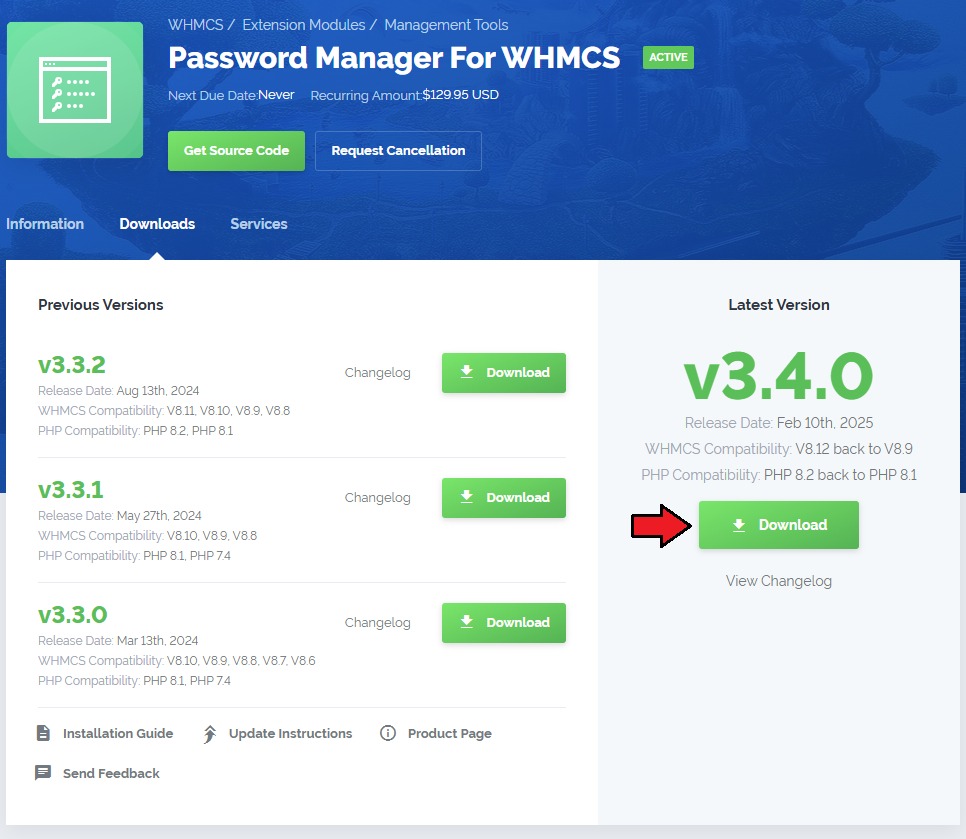
|
| 2. Extract the package and upload its content into the main WHMCS directory. The content of the package to upload should look like this. |
| 3. When you install Password Manager For WHMCS for the first time you have to rename 'license_RENAME.php' file. File is located in 'modules/addons/PasswordManager/license_RENAME.php'. Rename it from 'license_RENAME.php' to 'license.php'. |
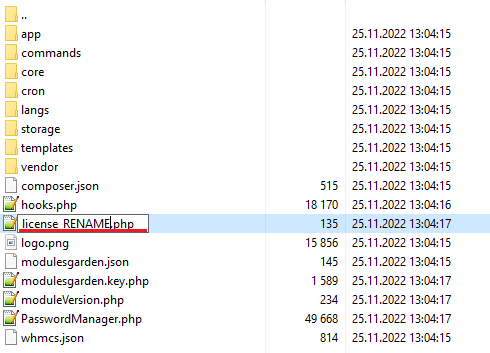
|
| 4. In order to configure your license key, you have to edit a previously renamed 'license.php' file. Enter your license key between quotation marks as presented on the following screen. You can find your license key in our client area → 'My Products'. |

|
| 5. Now, set up the 'storage' folder as recursively writable. This folder is available at '/yourWHMCS/modules/addons/PasswordManager/'. |
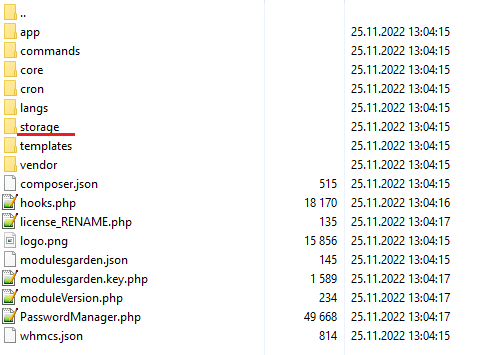
|
| 6. Now you have to activate the module in your WHMCS system. Log in to your WHMCS administrator area. Go to 'System Settings' → 'Addon Modules'. |

|
| 7. In the next step, you need to permit access to the module. To do so, click on the 'Configure' button, select administrator groups that should have access to this addon, and press 'Save Changes'. |
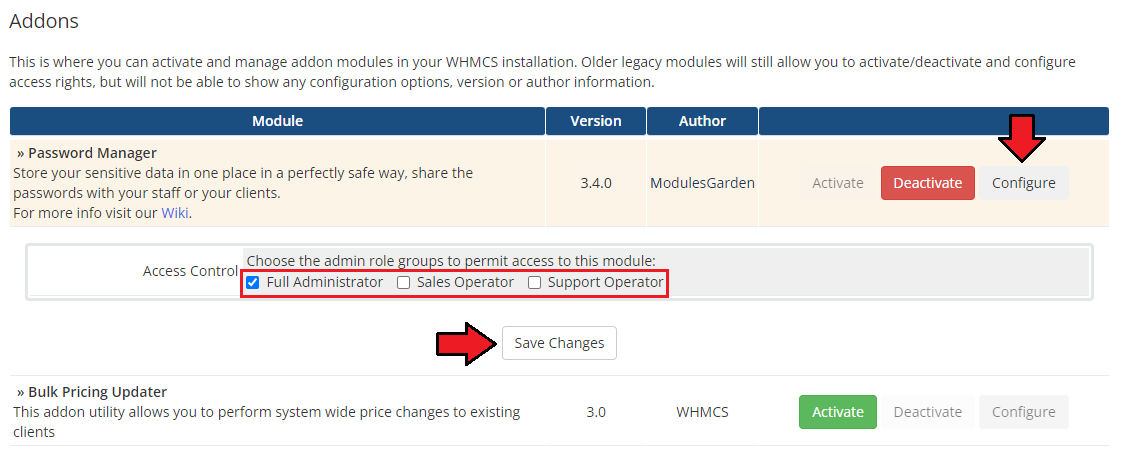
|
| 8. You have just successfully installed Password Manager For WHMCS! You can access your module under 'Addons' → 'Password Manager'. |
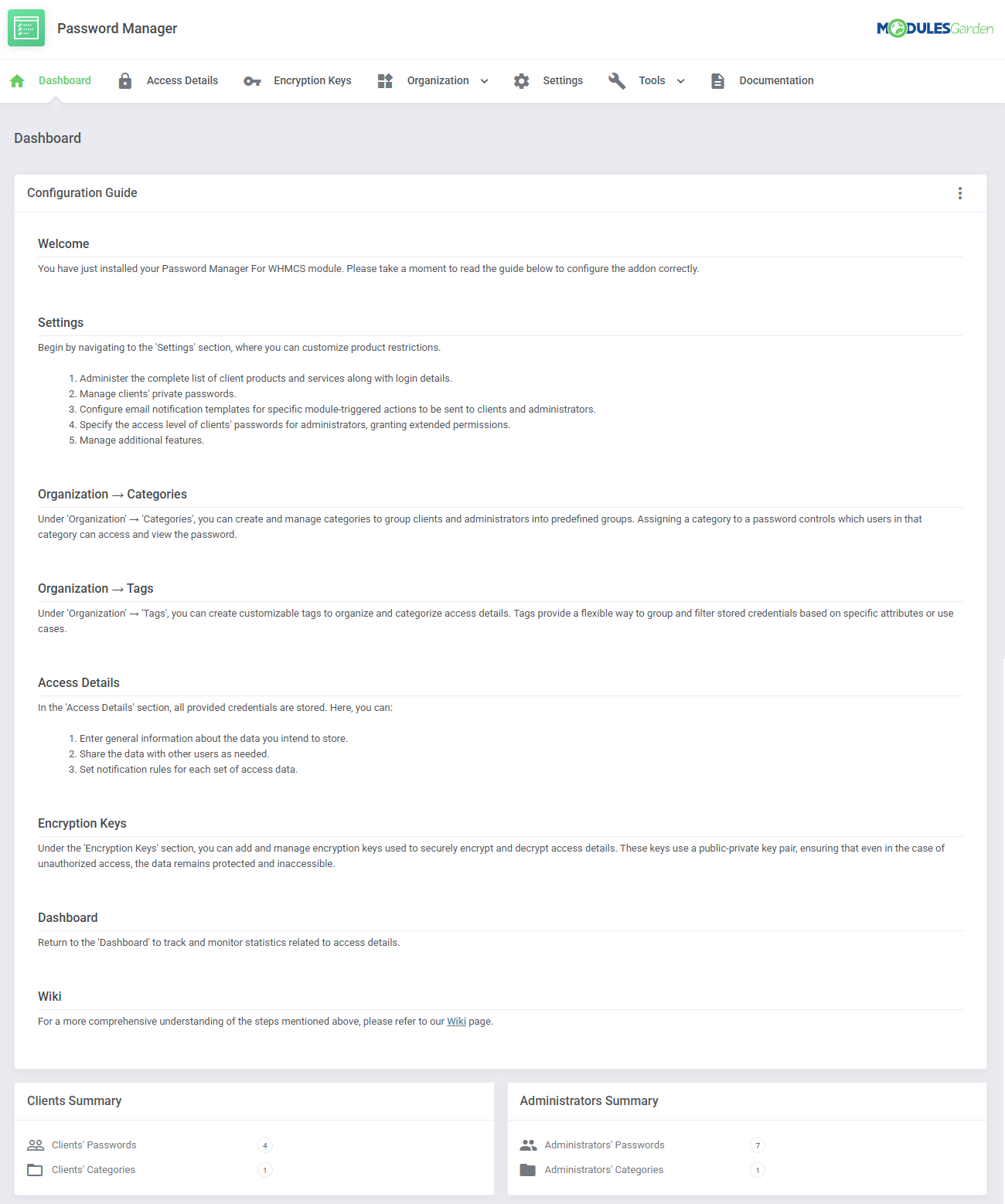
|
Configuration and Management
| Password Manager For WHMCS allows to safely store and share fragile data within your WHMCS. In this short guide, we will present you all the possibilities of our module. |
Configuration
| Before you start your work with our Password Manager For WHMCS, please move to 'Settings' tab, where you will configure access restrictions to product passwords, define email notifications and manage security settings. |
Products/Services Password
| First of all, decide whether you wish to allow to display a full list of the client's products and services' login details by selecting the option: 'Client Products/Services Password'. If enabled, access details to client's products and services will be displayed in the client area → 'Password Manager'. 'Exclude Client Groups' - enter any client group name to disable the product's access details from being displayed for clients in these groups. |
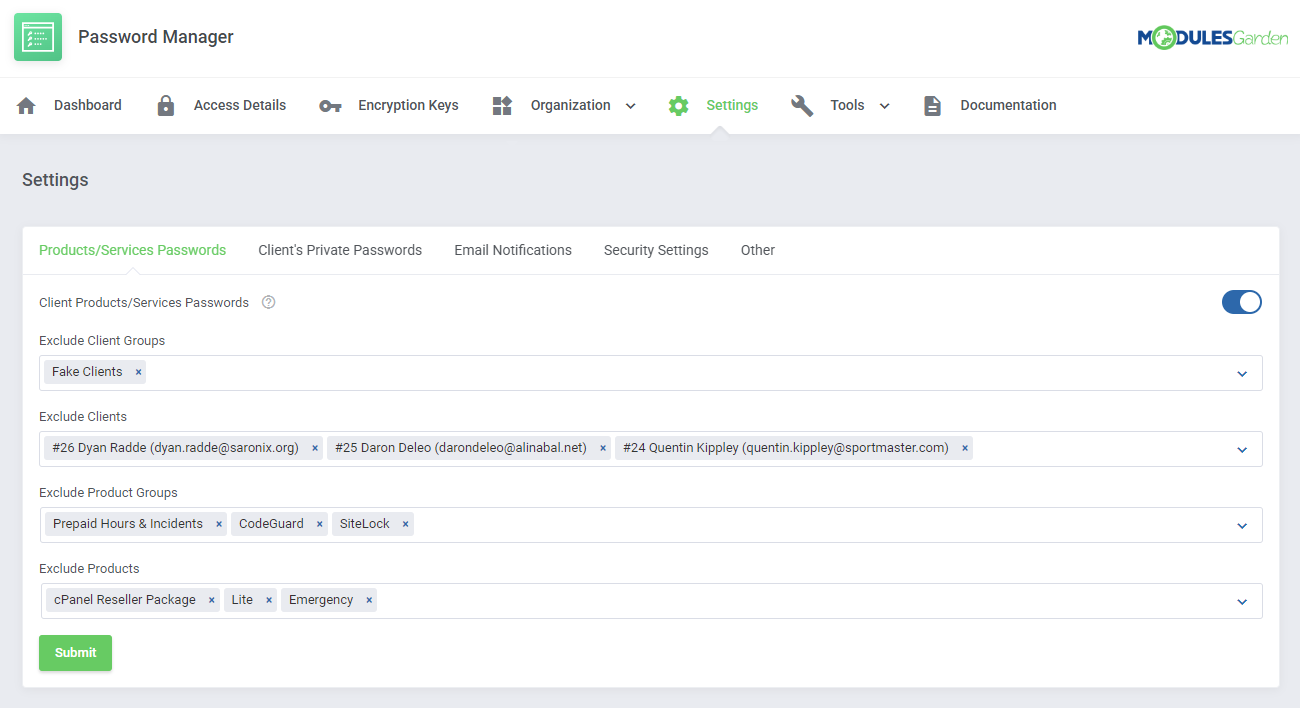
|
Client's Private Passwords
| The next section is dedicated to the management of private passwords of clients. If you wish to allow your clients to manage their personal access details, select the 'Client's Private Passwords' option. Your clients can be also permitted to set their own 'Master Password' to provide additional protection for their stored passwords. Next, move to the specific configuration: 1. 'Exclude Client Groups' - disable private access details management for selected here client groups. |
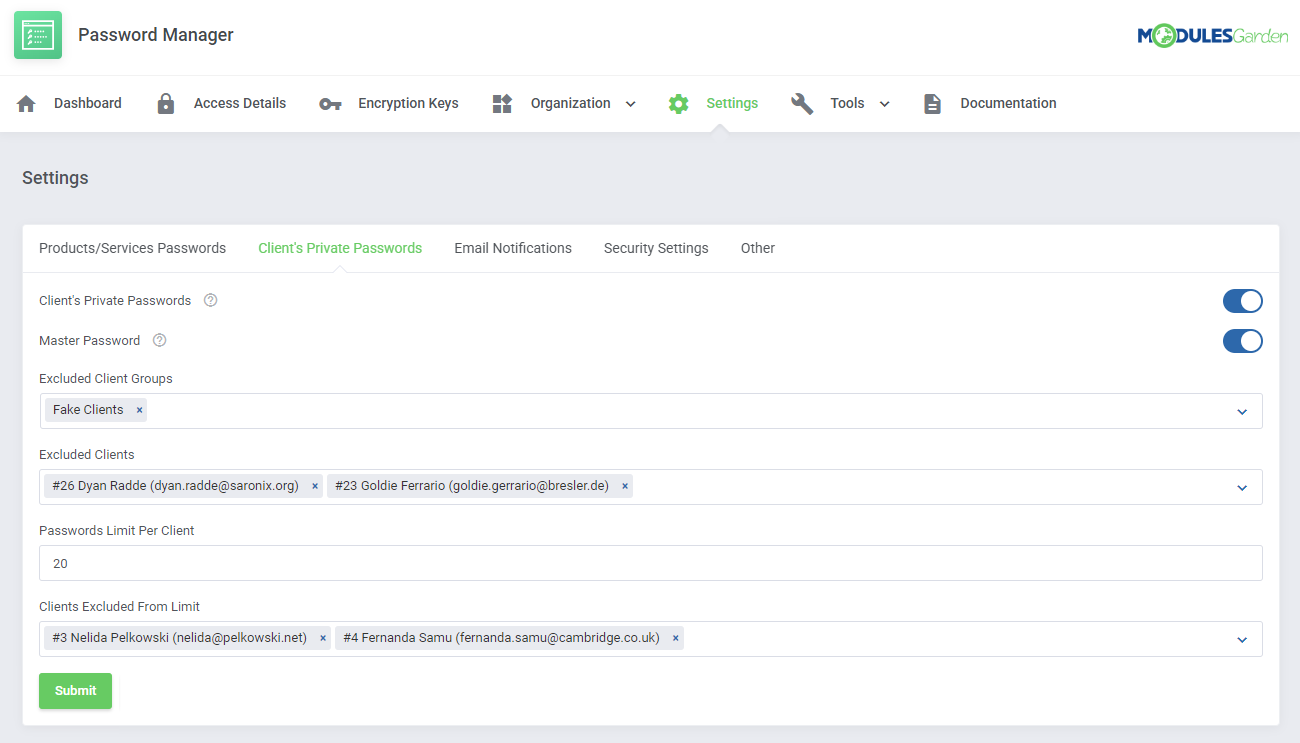
|
Email Notifications
| This section allows you to define email notification templates that will be sent by the module on specific actions to clients and administrators. 1. 'Password Change Reminder' - select an email template that will be used to remind clients or administrators about the need to change the password. |
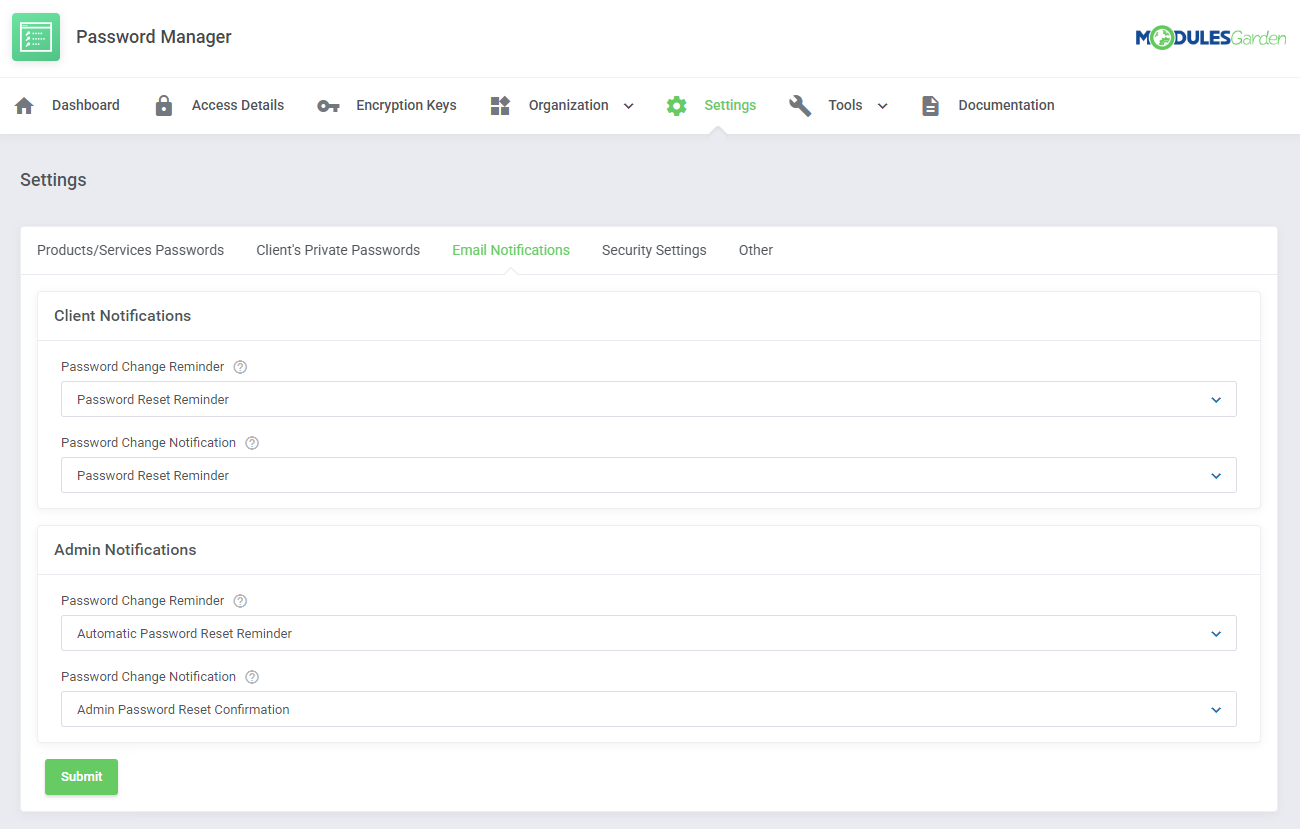
|
Security Settings
| Under the 'Security Settings' tab, you have to define the level of access to clients' passwords for administrators and grant them extended permissions. You may grant your administrators:
You may also select here administrators group which will be granted 'Extended Permissions'. |
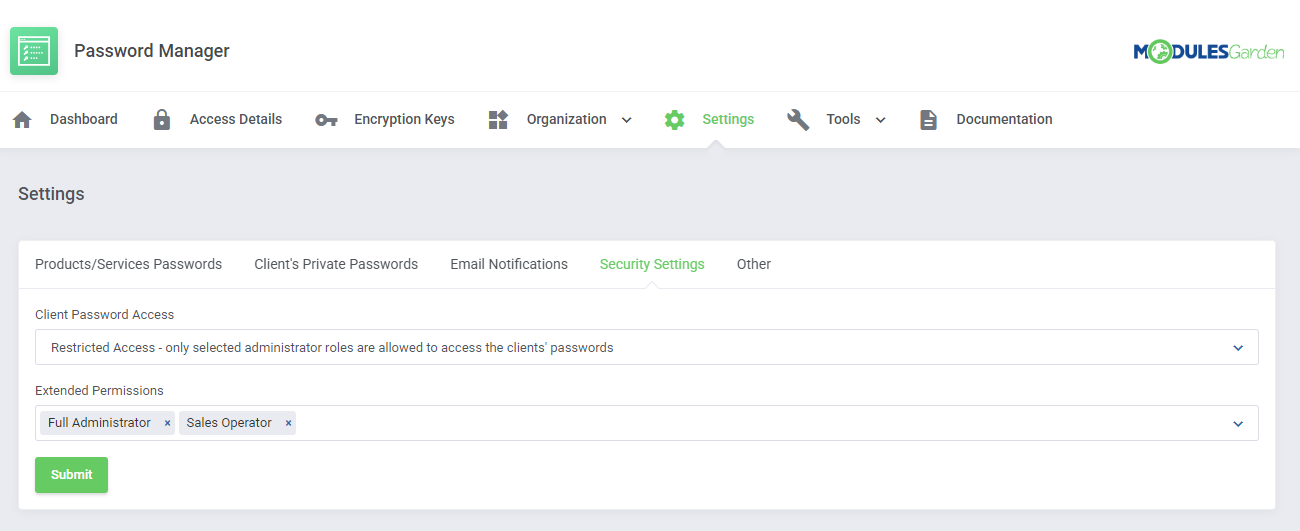
|
Other
In the very last section you may manage additional options that 'Password Manager For WHMCS ' has to offer.
|
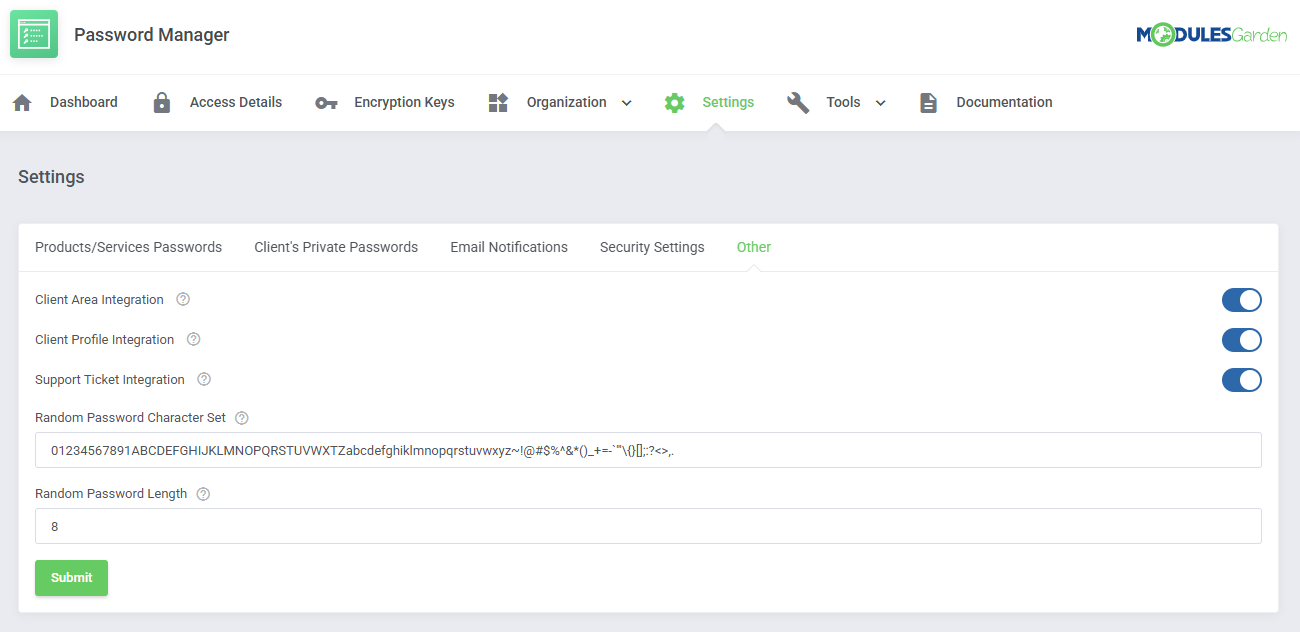
|
Categories
| Categories allow you to prepare predefined sets of clients and administrators. By assigning a category to a password, clients and administrators from that category are granted permission to view this password. |
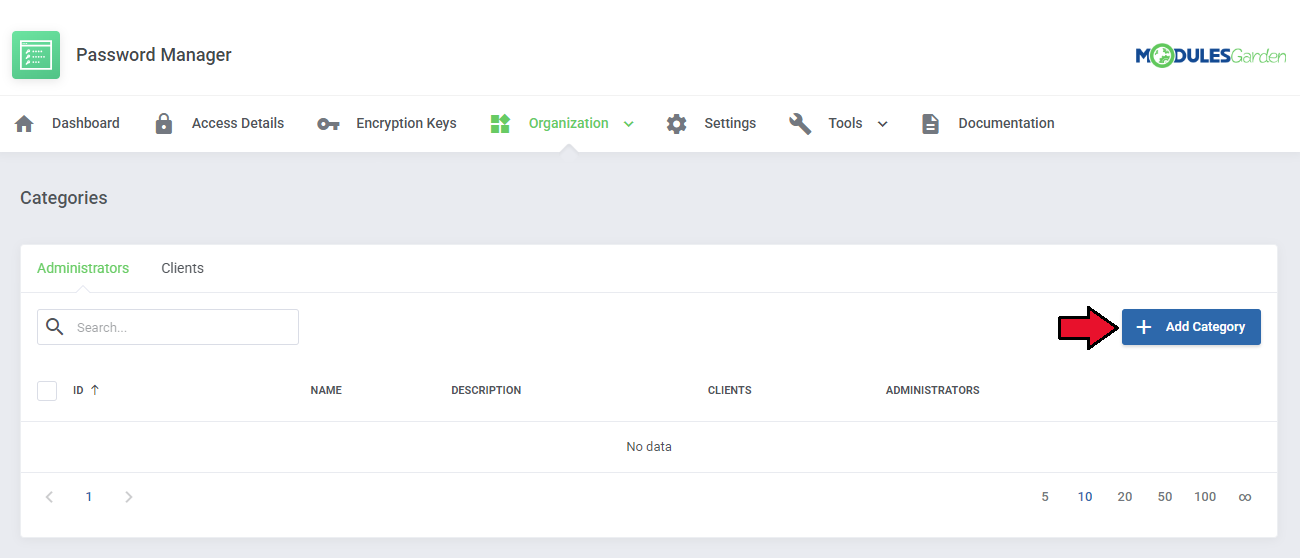
|
| Now, fill out the form with the category name and description. Assign desired clients and administrators to the category and press 'Confirm'. |
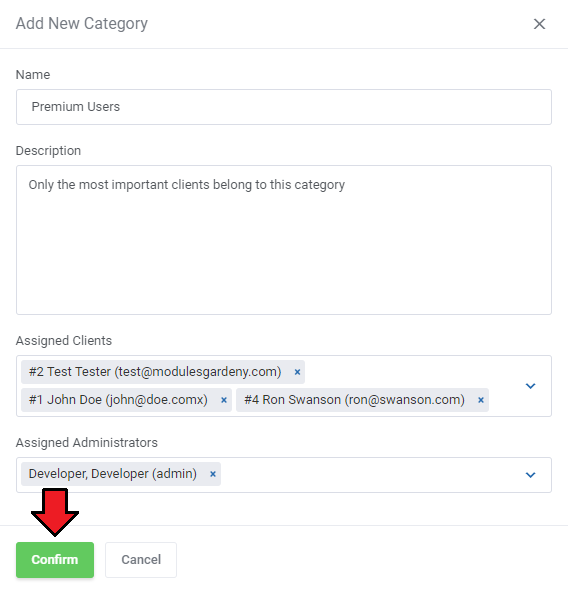
|
| The list of administrator categories with any details such as listed clients and administrators allowed to access the details is now visible. You may always edit the category or delete it if needed. Use the action buttons to do so. |
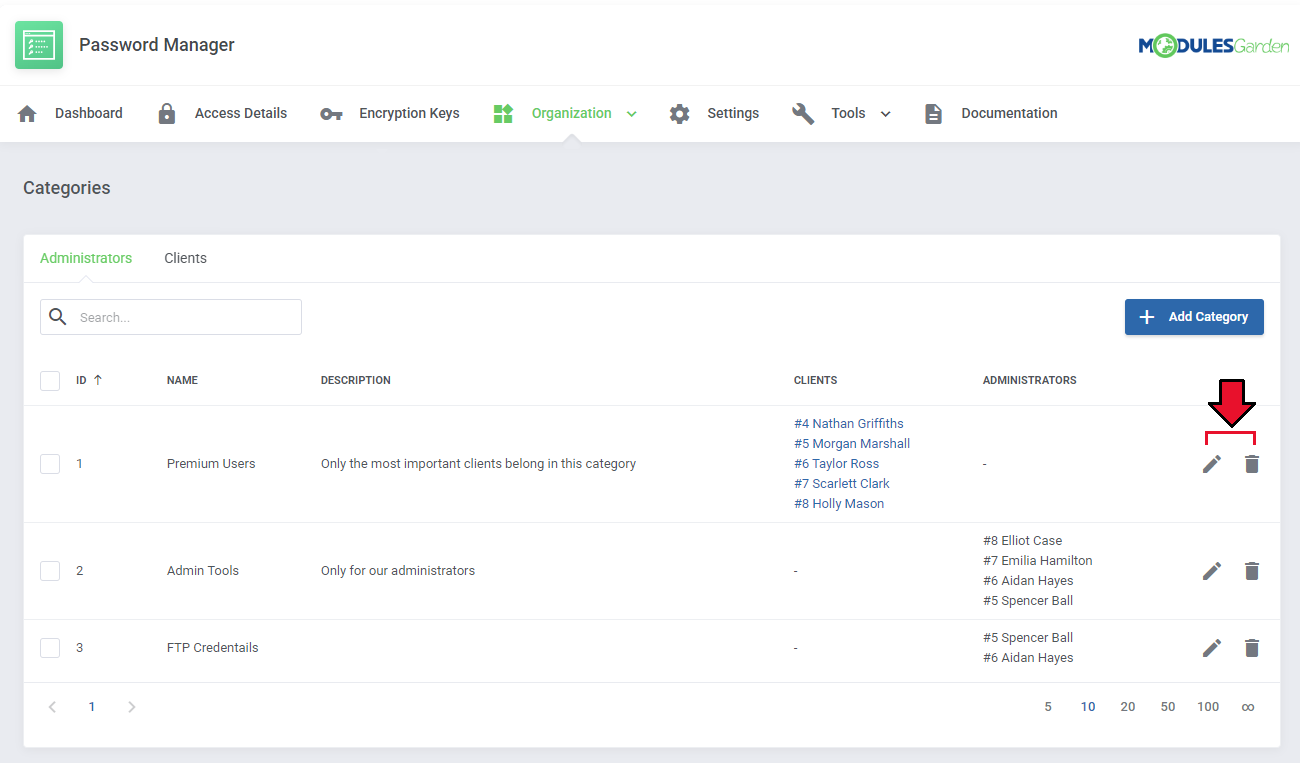
|
Access Details
| 'Access Details' section includes a list of provided access details. Here you can create new access details and decide who can view them. Press 'Add Details' to begin. |
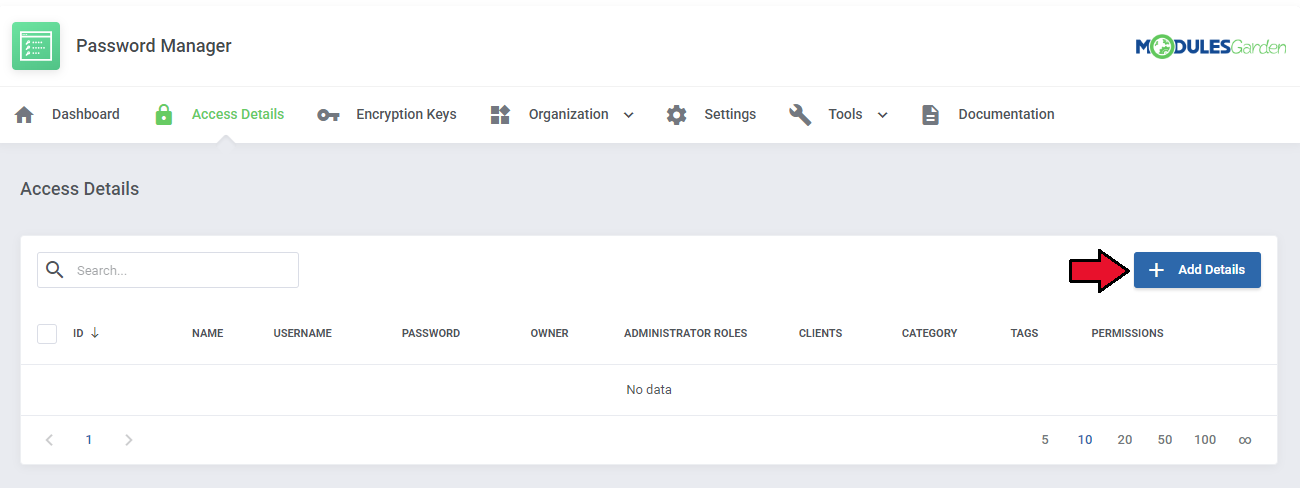
|
| Fill in 'Name', enter access details into 'Username' and 'Password'. You can also make your logging in easier by entering the website URL and website login URL consecutively into 'Website URL' and 'Login URL'. |
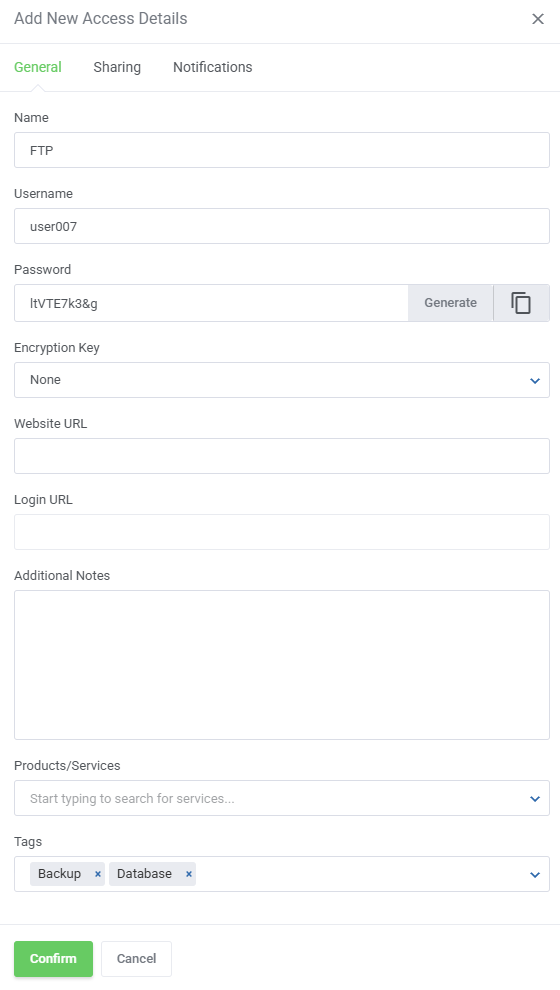
|
| In this section choose 'Category' and select 'Administrators', 'Administrator Roles' and 'Clients' who should have access to this details. Note: There is disjunction relation between 'Administrators' and 'Administrator Roles'. |
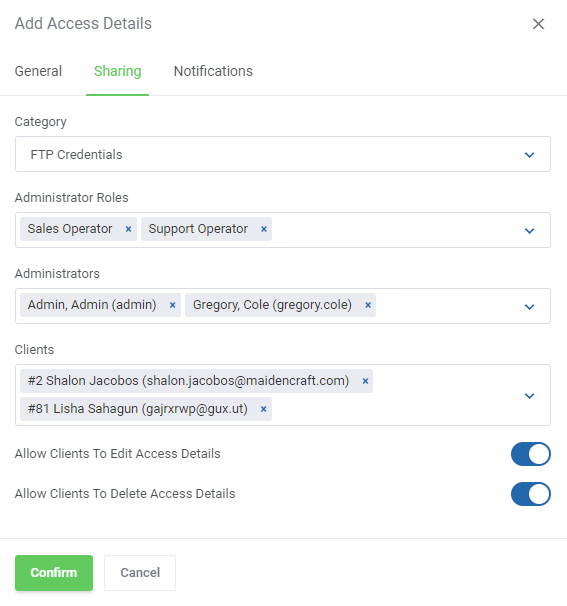
|
| Finally, you can set up notifications rules. 'Allow To Change Password' - message is sent upon password being changed. |
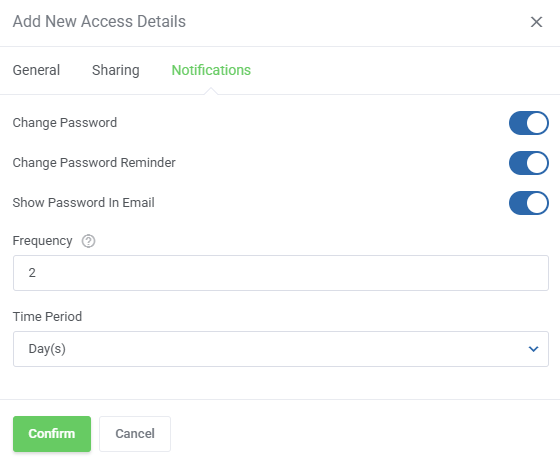
|
Access Details List
| On the list of access details you will see some basic info, such as ID and name, username and password with the possibility to view the password (press the hidden password to make it visible). Press the "Copy" icon and the password or username will be copied to the clipboard. There is also information on the access details owner and administrator groups allowed, list of clients allowed and category assigned. |
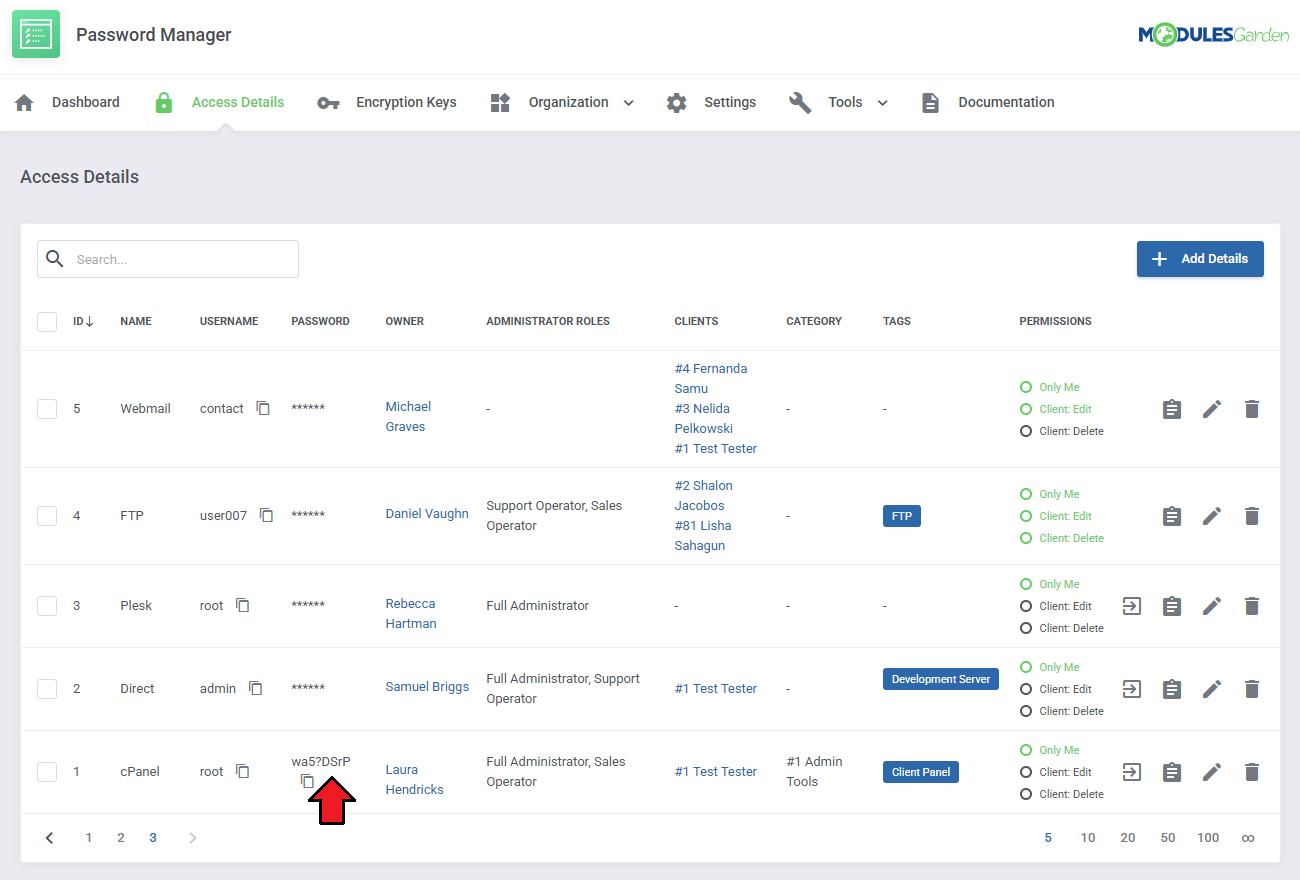
|
| Use action buttons to manage the entered access details.
1. Log into your website (if URL has been provided) |
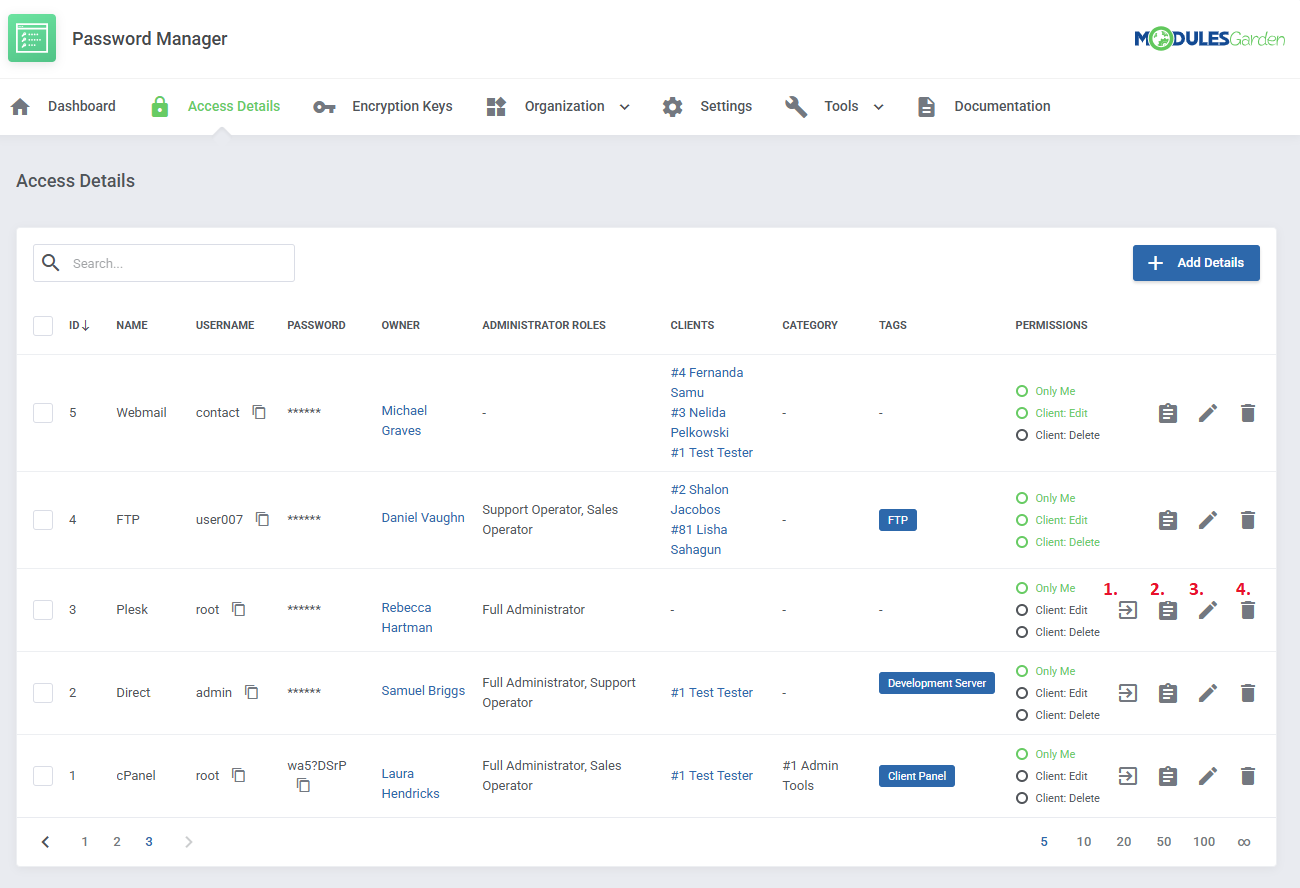
|
Dashboard
| A short summary of the clients' and administrators' access details and categories is available on the dashboard. The last tab in the addon is 'Documentation'. When pressed, it redirects you to this very site. |
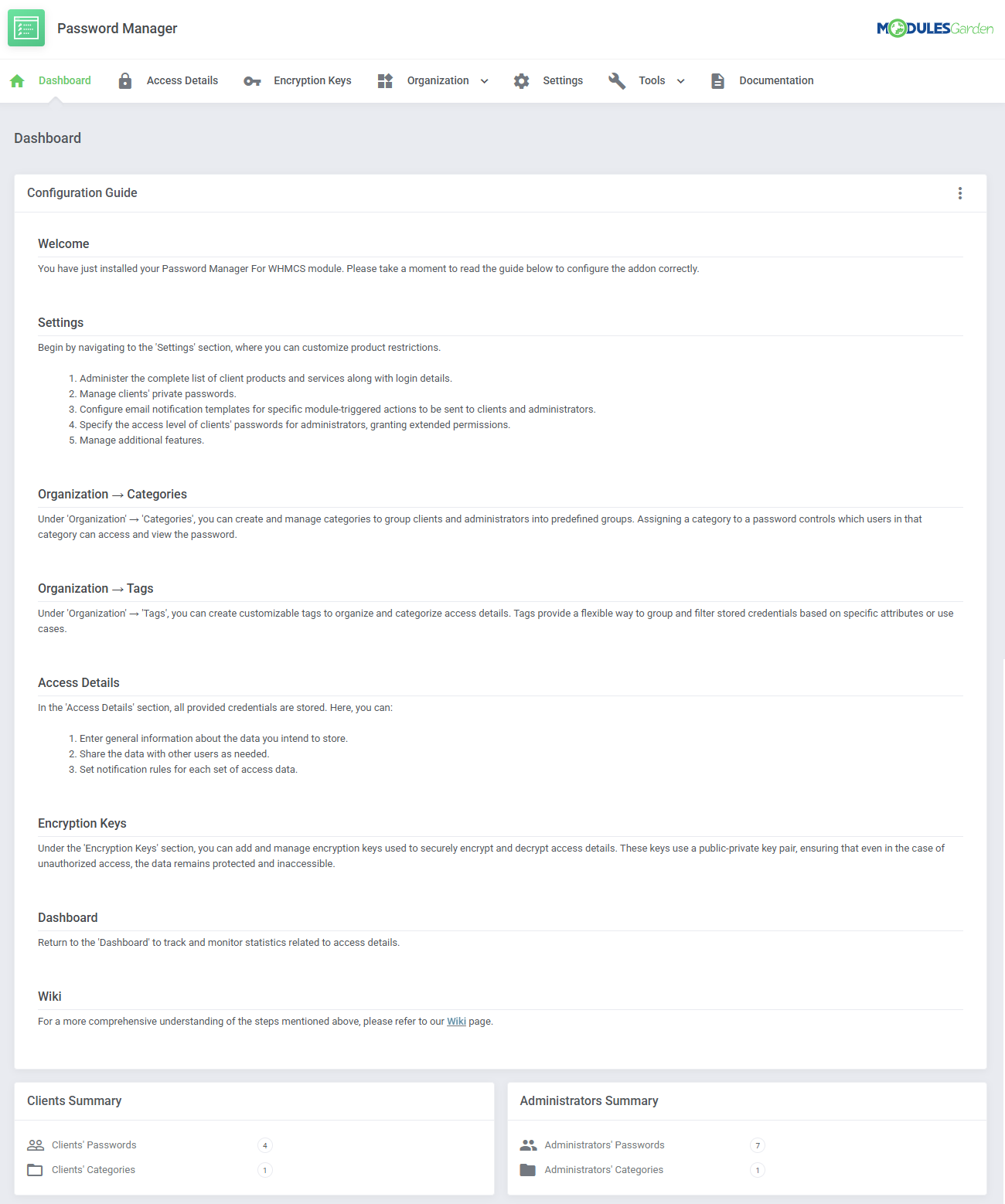
|
Translations
| Customizing language files is now extremely easy with the "Translations" tool that is now available directly in the addon. Its user-friendly design makes managing various language file tweaks a smooth and efficient process. Prepare translations for the original English files with this handy built-in tool. For specific instruction on how to use this tool please refer to its dedicated article, you will find it here. |
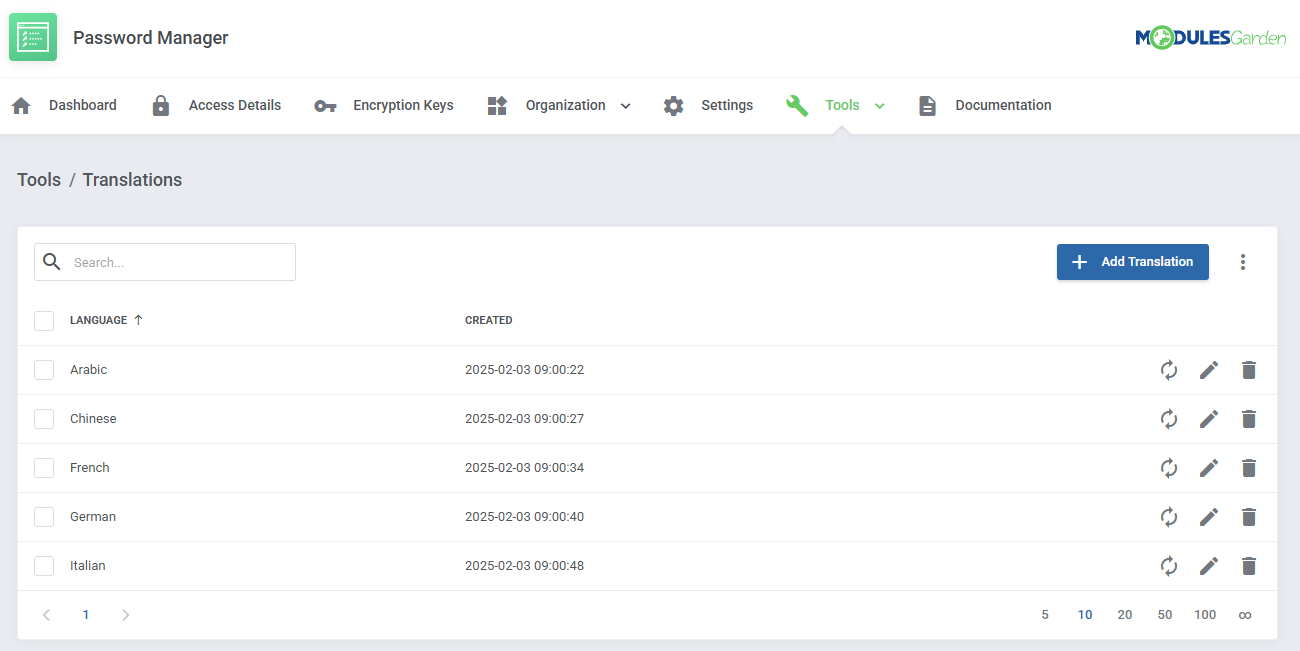
|
Access Control
| 'Access Control' allows you to specify and control exactly which sections of the module can be accessed by your administrators. The way it works is that you create access control rules in which you decide if a specific admin, or admin role has full access, or is restricted to only specific sections. |
Rules
| Start with creating a new rule, click on the 'Create Rule' button and a dedicated form will appear. Below you will find a description of every field required in the form. |
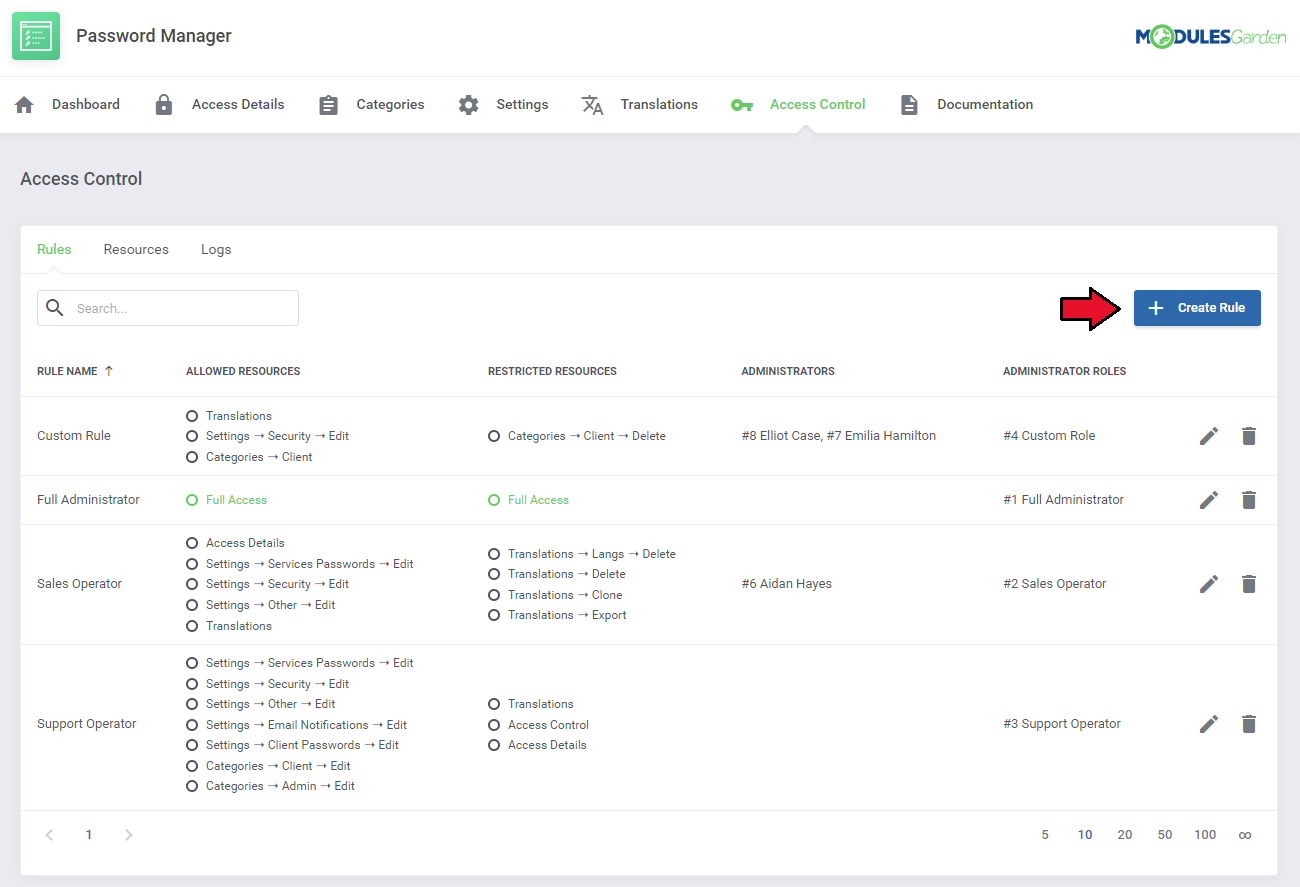
|
Fill out the following fields to create resources access rule:
Important: When picking specific sections, keep in mind that allowing a parent section will also allow all of its children. |
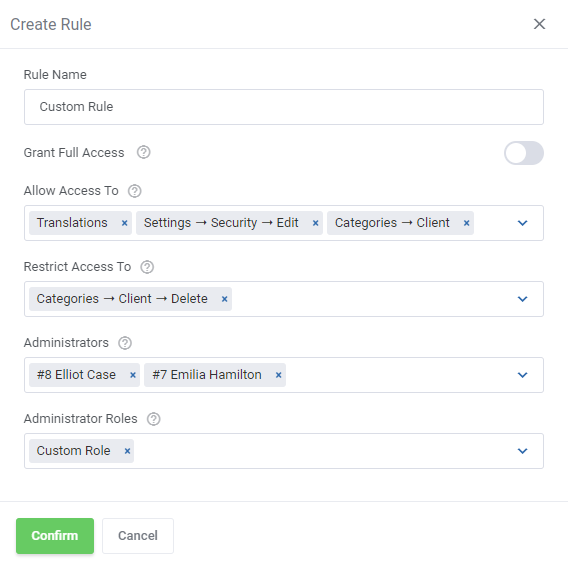
|
| To edit or delete existing rules, use the icons to the right. |
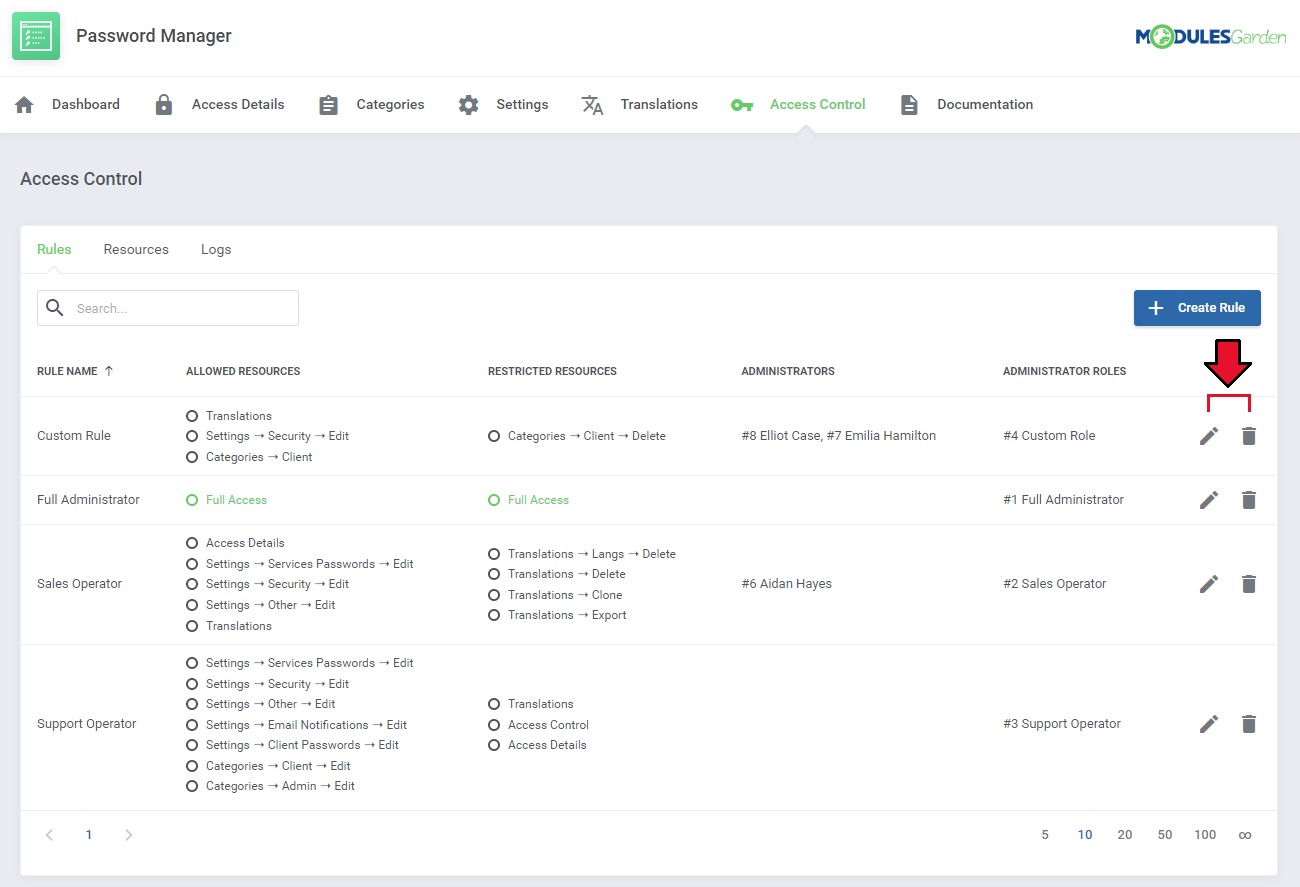
|
Resources
| Use the toggles in the 'Resources' section to specify which of them should be subject to logging, found in the 'Logs' section. Every time an administrator requests a toggled resource, it will be recorded. |
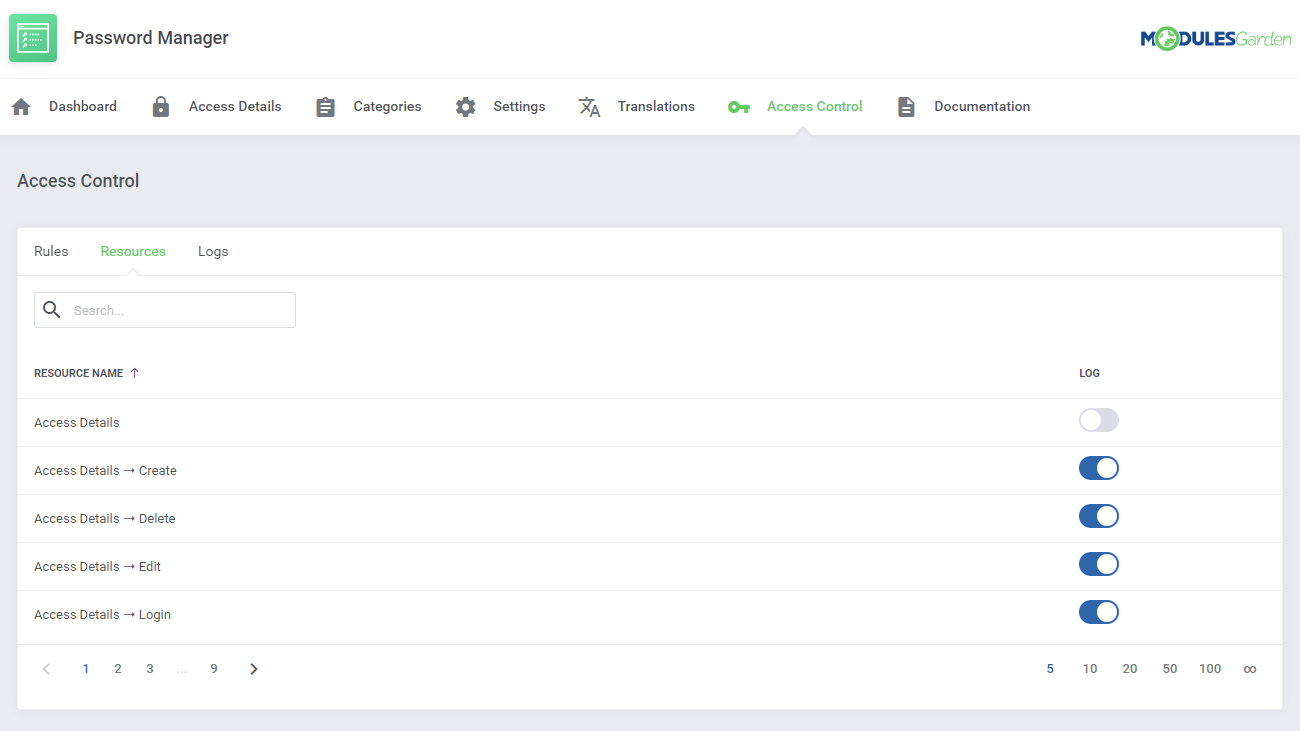
|
Access Control Logs
The logs section includes:
Use the trash bin icons to delete specific logs, or utilize the mass action function to delete multiple logs at once. |
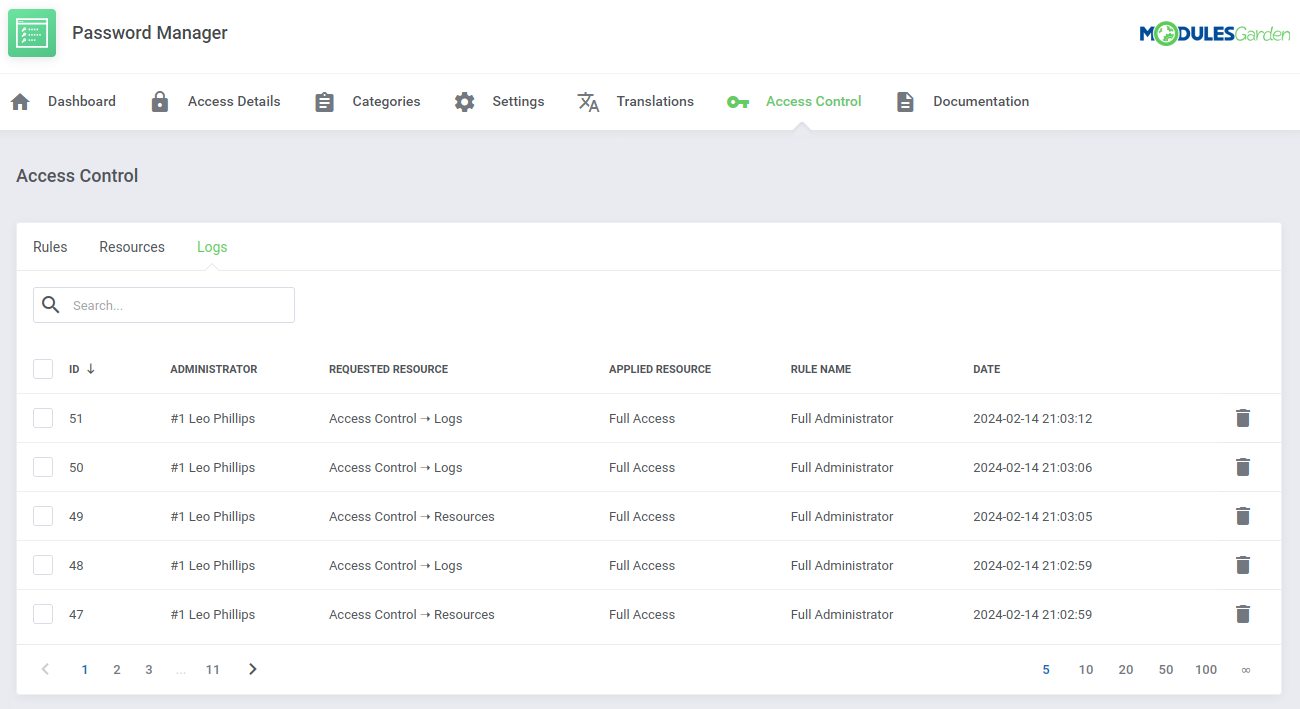
|
Administrator Area Integration
| Our module integrates with your administrator area as well as the client area. Passwords of any client can be viewed on the summary page as it is shown below, but only if you enable this option in 'Settings' section in the addon. |
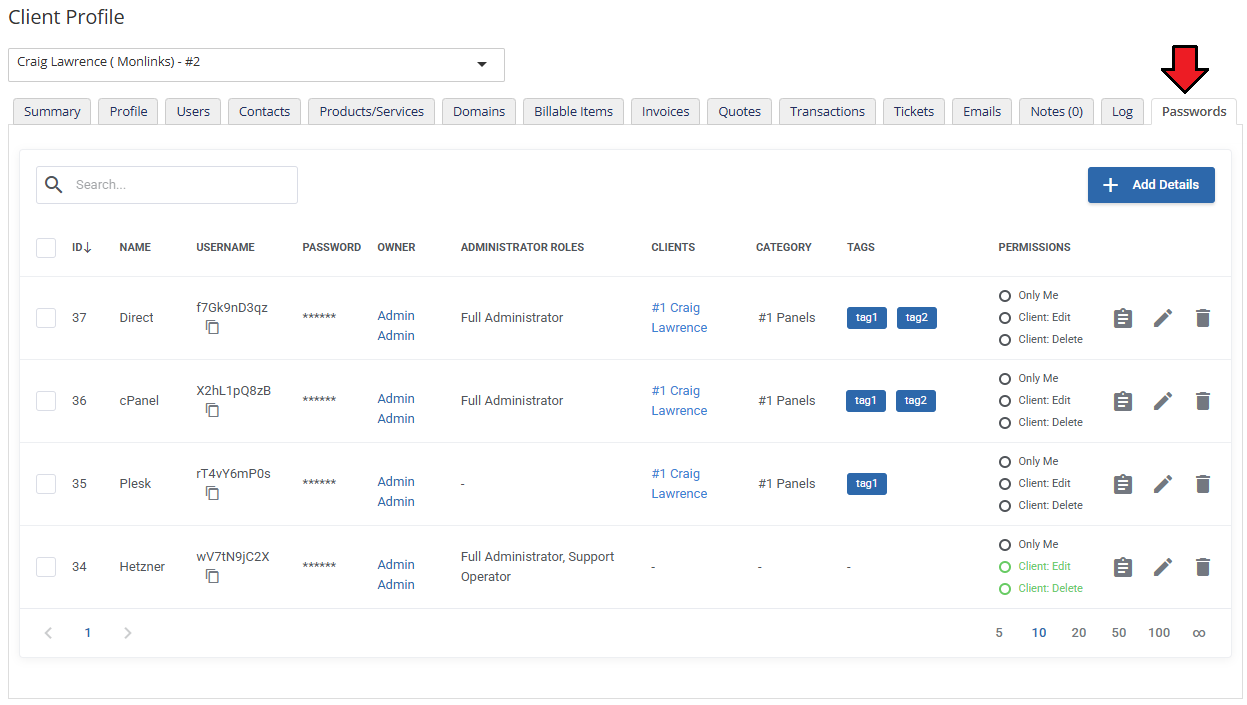
|
| Your support operators are also able to access clients' passwords from within the ticket. As you may have noticed, these places allow them not only to see passwords but also to create new ones. |
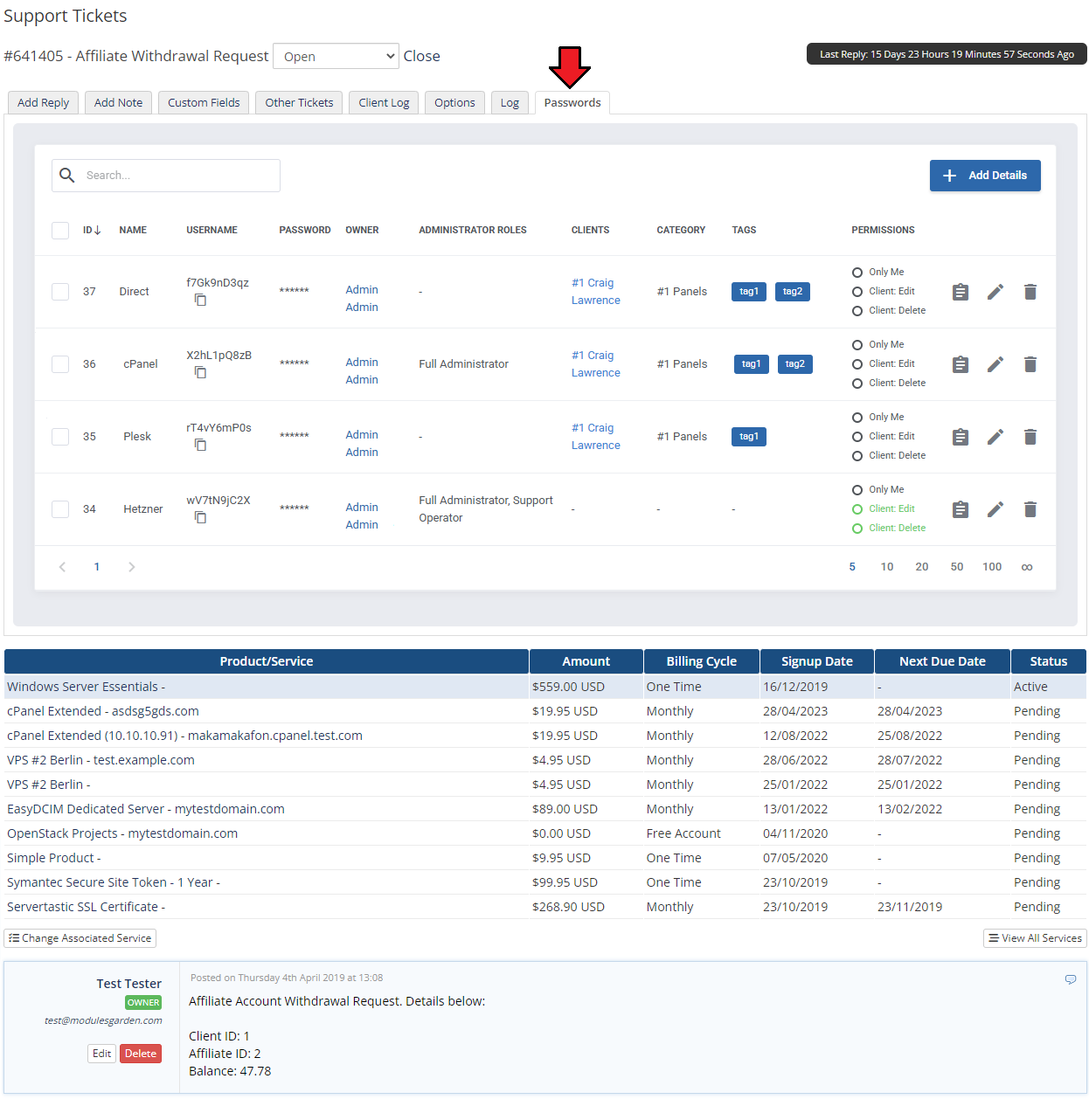
|
Client Area
| Your clients can access client area password management page through 'Password Manager' button in navigation bar. To allow integration with the client area, a proper option must be enabled in 'Addon' → 'Settings' → 'Other'. |
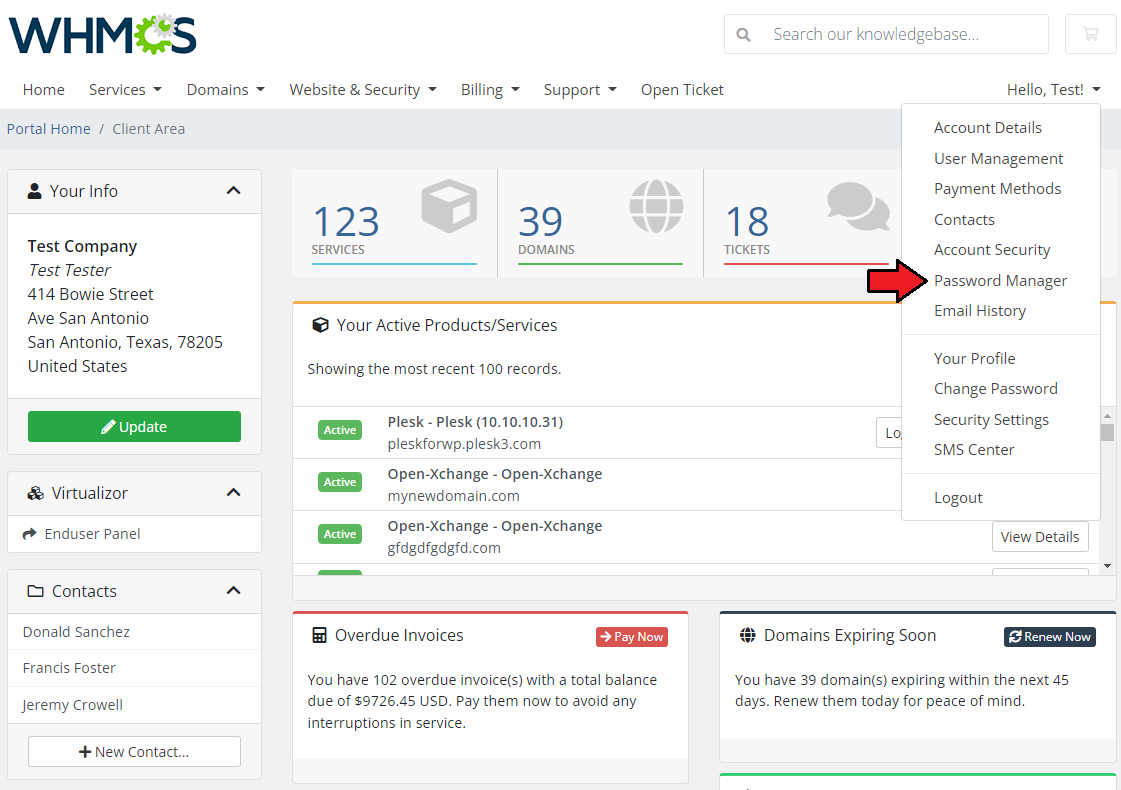
|
| In 'Password Manager', your clients can view access details depending on the settings configured by the administrator and the level of access allowed for the client. Underneath you can see a client's area with full access to any option given. As you can see, there are four sections available: 'Owned Passwords', 'Shared Passwords', 'Products/Services Passwords' and 'Categories'. |
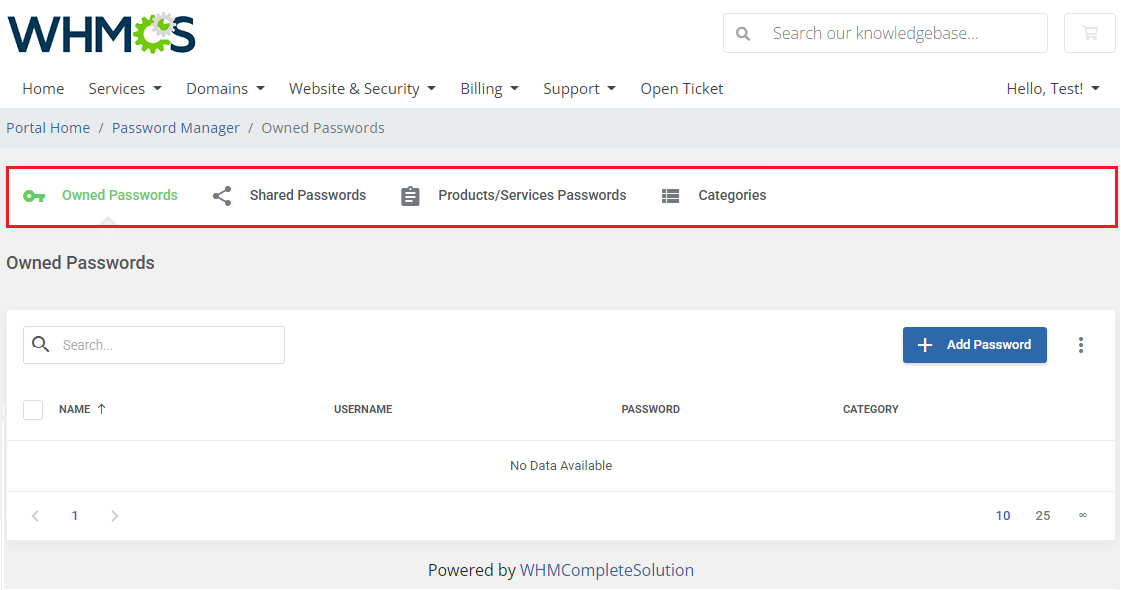
|
Owned Passwords
| If you enabled 'Client Private Passwords' your clients will be allowed to view, manage and create their own access details. Please note that 'Shared' column with information on whether the details are allowed for administrators or not is available only if you select 'Shared Access' in the addon's settings. |
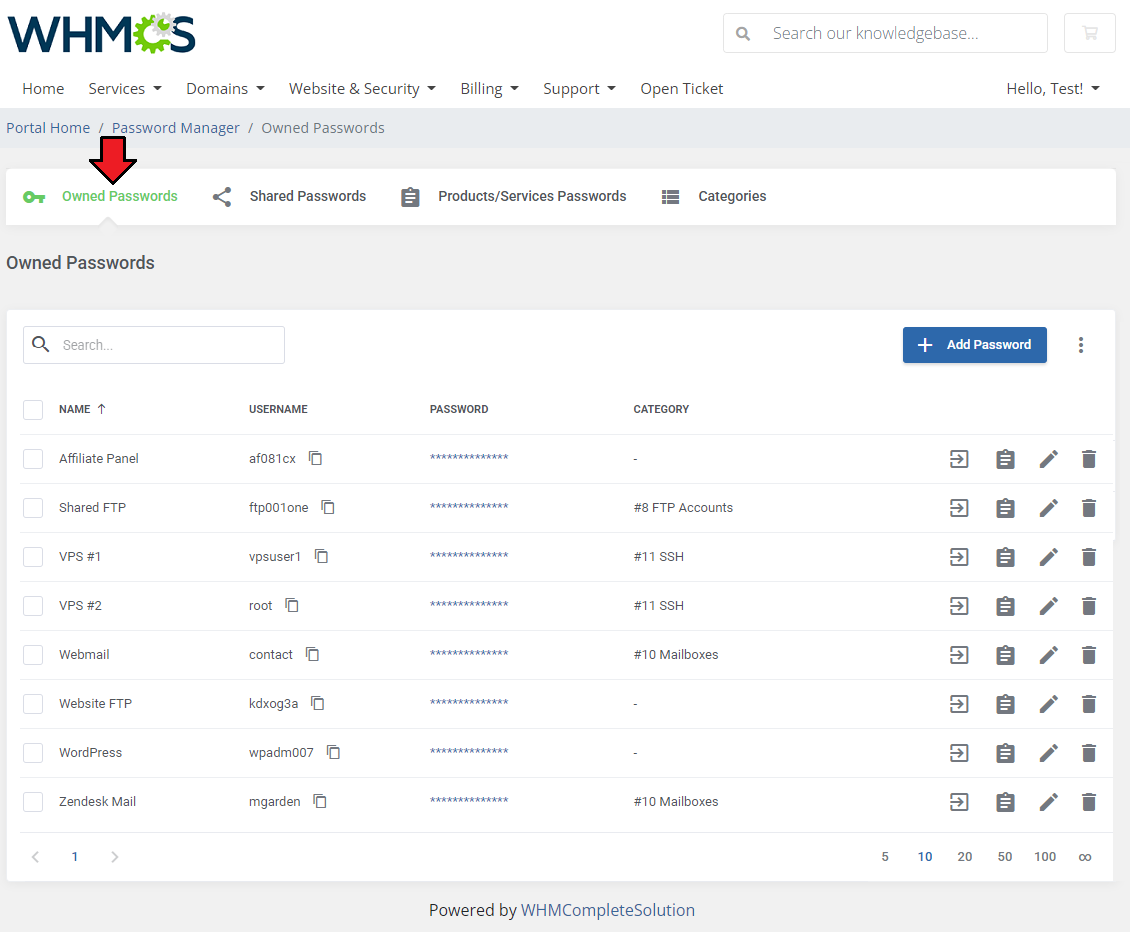
|
| Preview the password and use action buttons to manage the access details:
1. Log into URL |
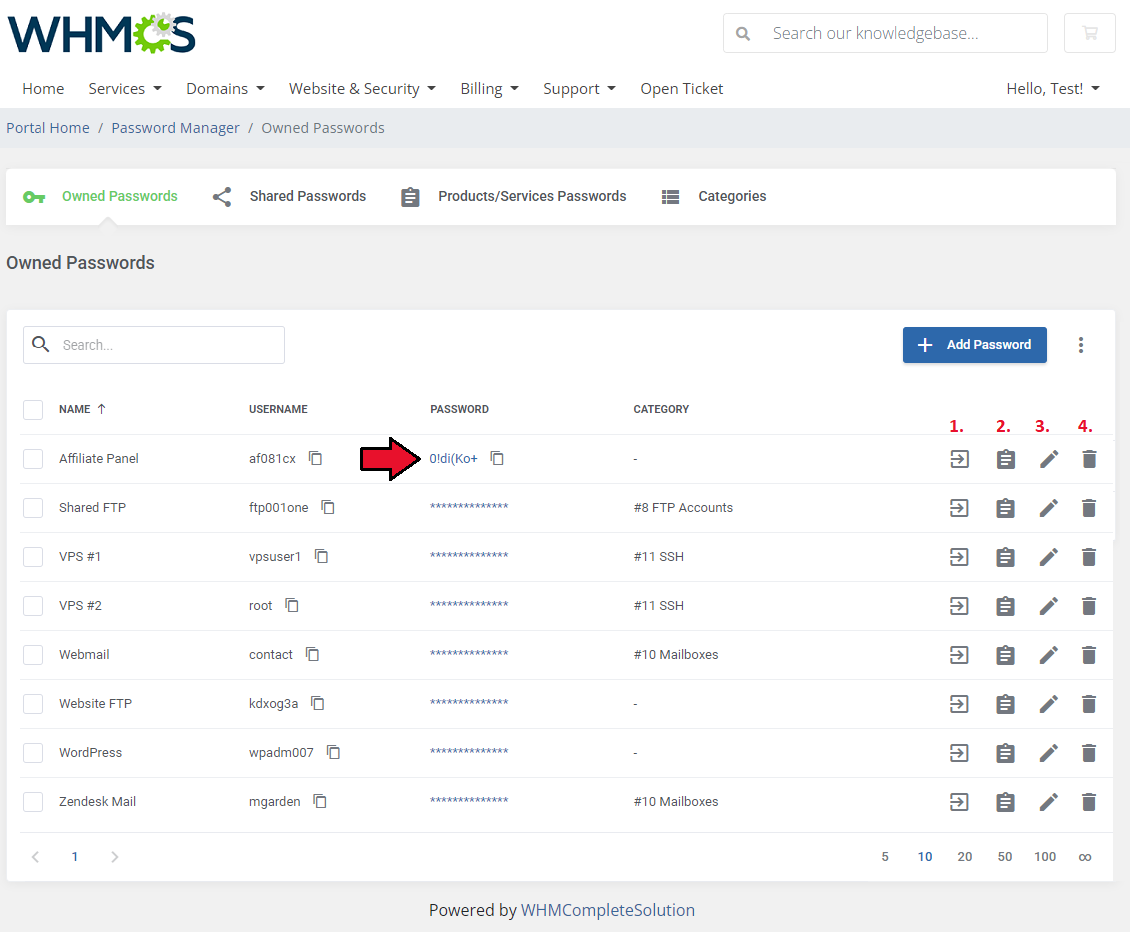
|
Add Access Details
| To create access details, press 'Add New' button as shown on the following screen. |
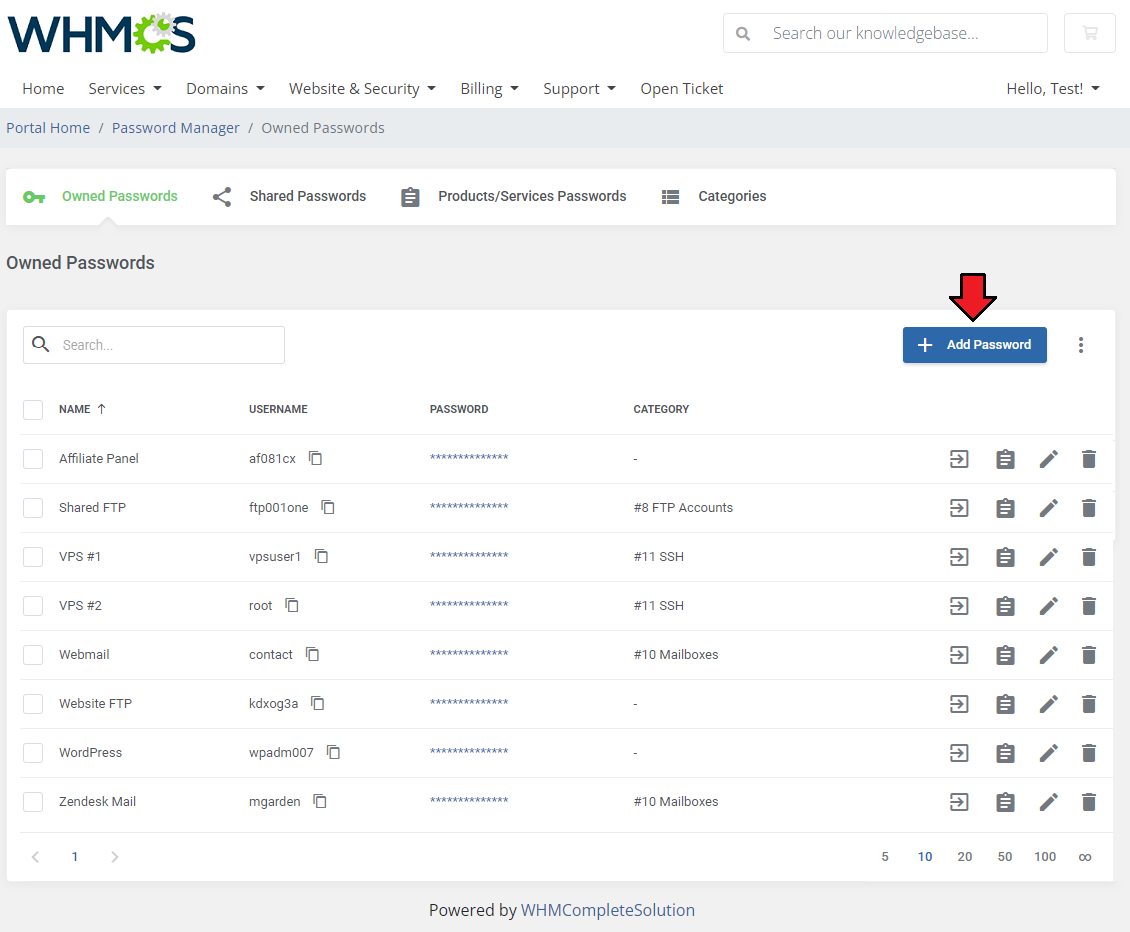
|
| Type the new password name and enter access details into 'Username' and 'Password'. You can also generate a random password. Optionally, provide 'Website URL' and 'Login URL' to be allowed to log into your site directly from the 'Password Manager' page. |
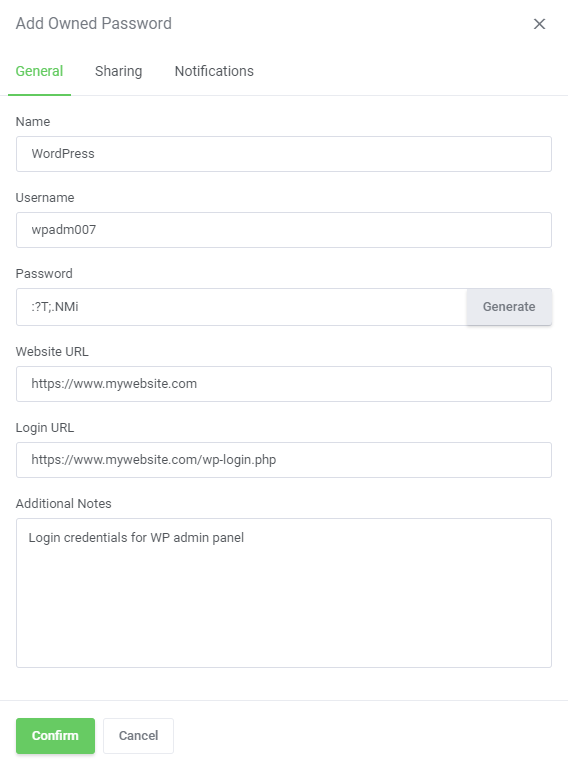
|
| You may now move to 'Sharing' section. There, you can decide which category the new access details will be assigned to. Choose one from the dropdown menu or select 'Unassigned' to leave it without any category. Depending on the category you select, the access details will be available for those specified in its configuration. Additionally, define which actions can be made on shared passwords. |
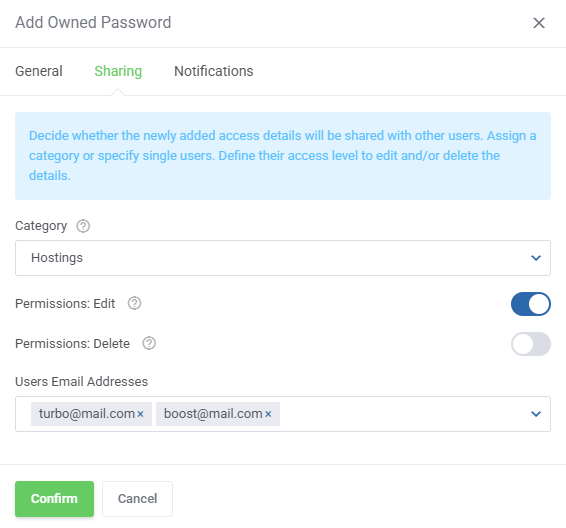
|
| Finally, in ' Notifications' section, set up conditions of delivering password notifications. Enable this option if needed and define when the reminders should be sent. You can also define whether you wish to receive the new password in the message. Do not forget to press 'Save Changes' to finish. |
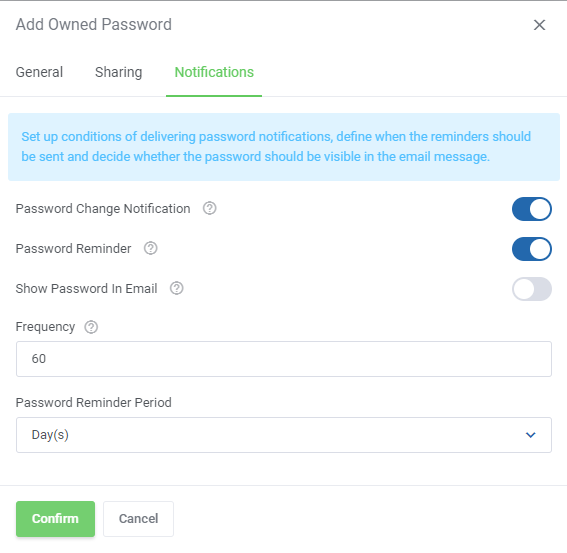
|
Addtional Actions
| If the administrator has enabled the 'Master Password' option in 'Client's Private Passwords' , the clients will have the ability to set additional protection for their owned passwords. |
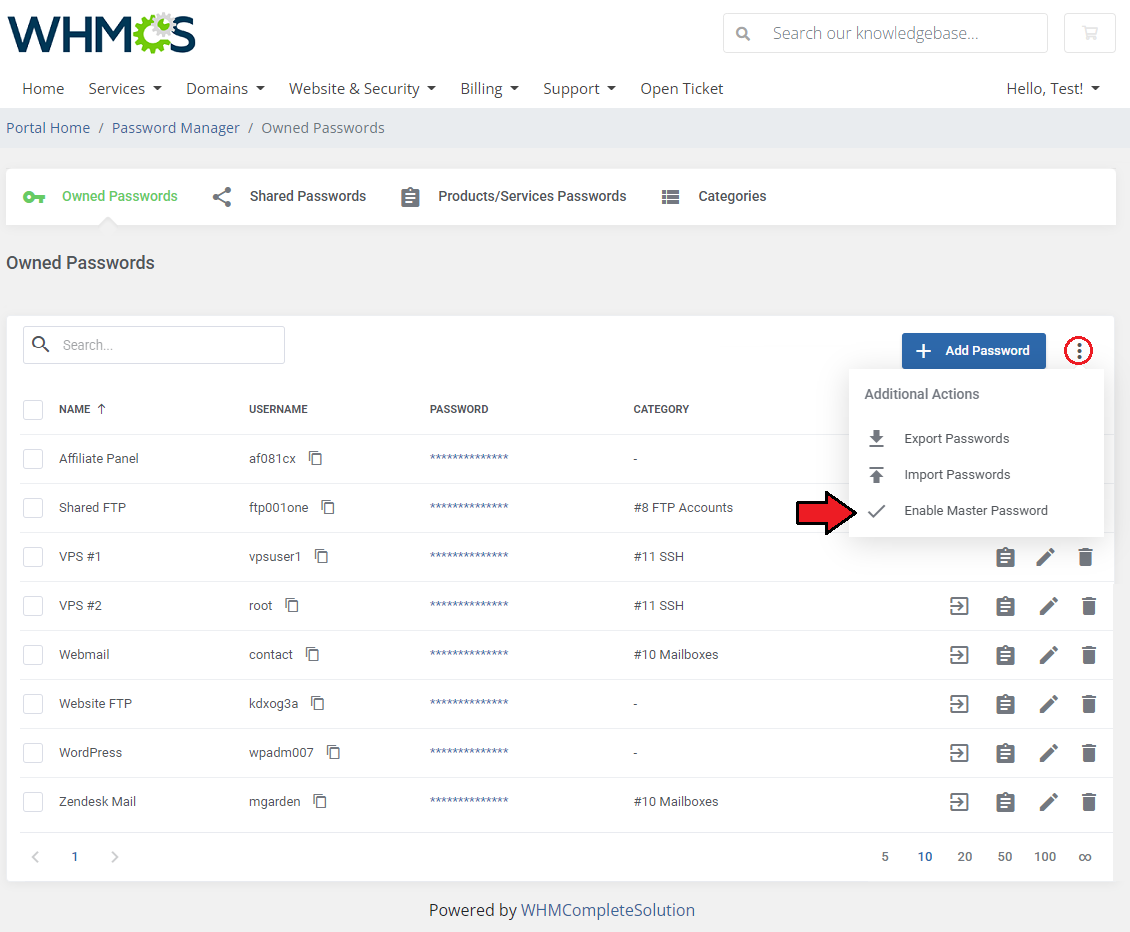
|
| Simply provide and confirm a new password that will protect the access to owned passwords. Note - if you lose or forget this password, you will also lose access to your saved credentials in this section! |
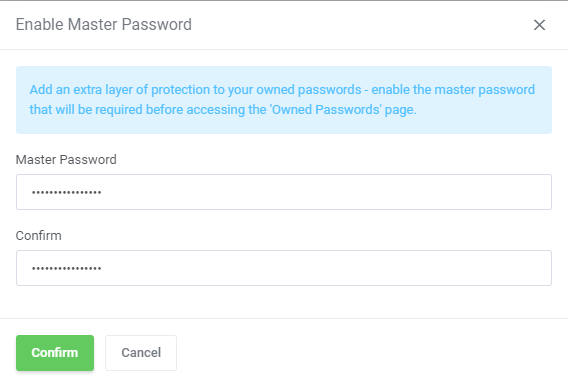
|
| From now on, access to the 'Owned Passwords' section will require the master password. |
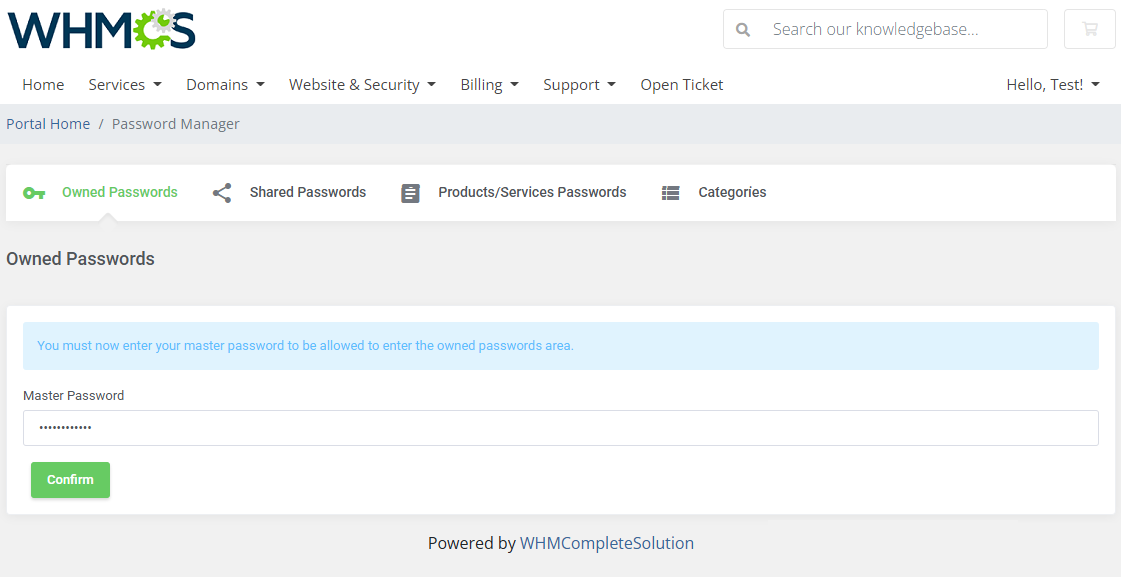
|
| You may change the password or disable this option at any time. |
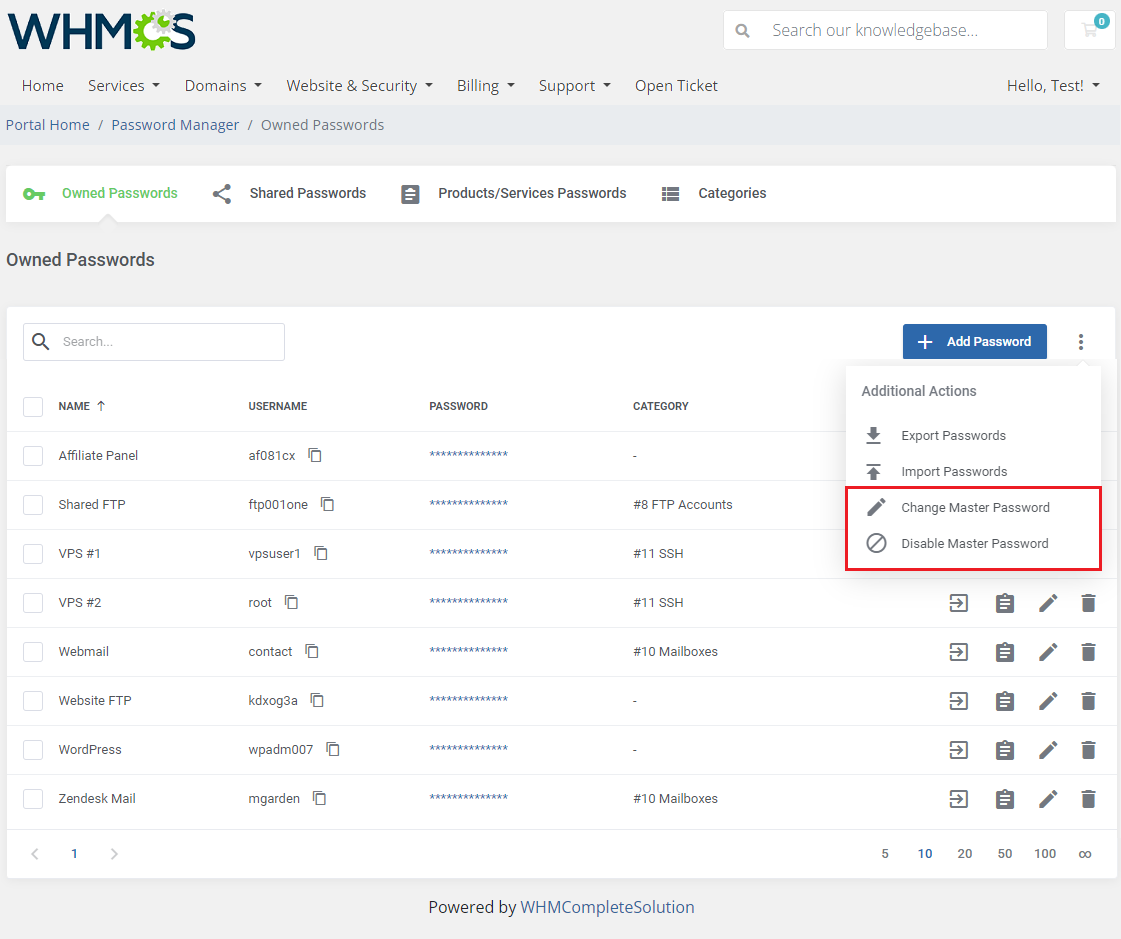
|
| Among the additional actions you will also find a feature that allows you to export the passwords to a file. Press and the generated file will be saved on your disk. |
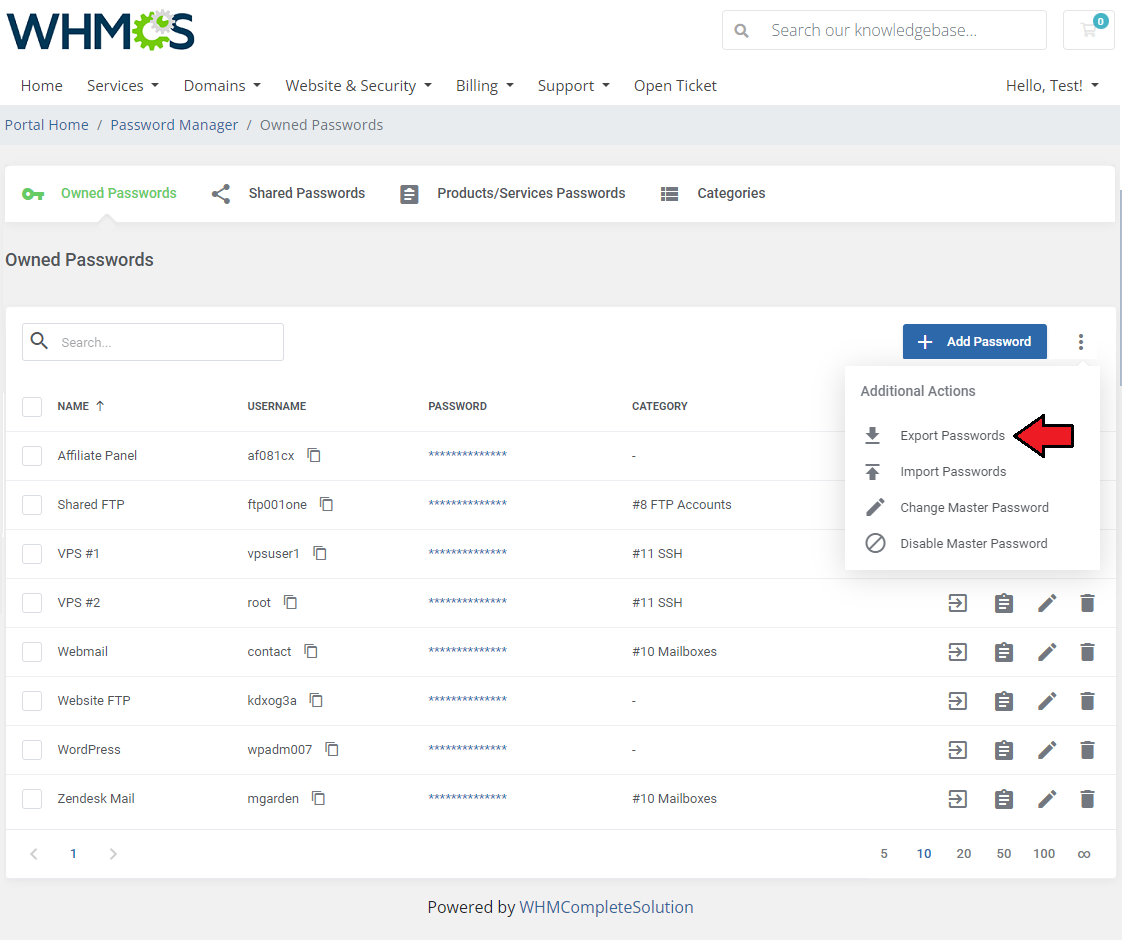
|
| You may also import your private passwords. Press the button and find a ready file to upload the passwords to the group of 'Owned Passwords'. You may upload files in a CSV format only. |
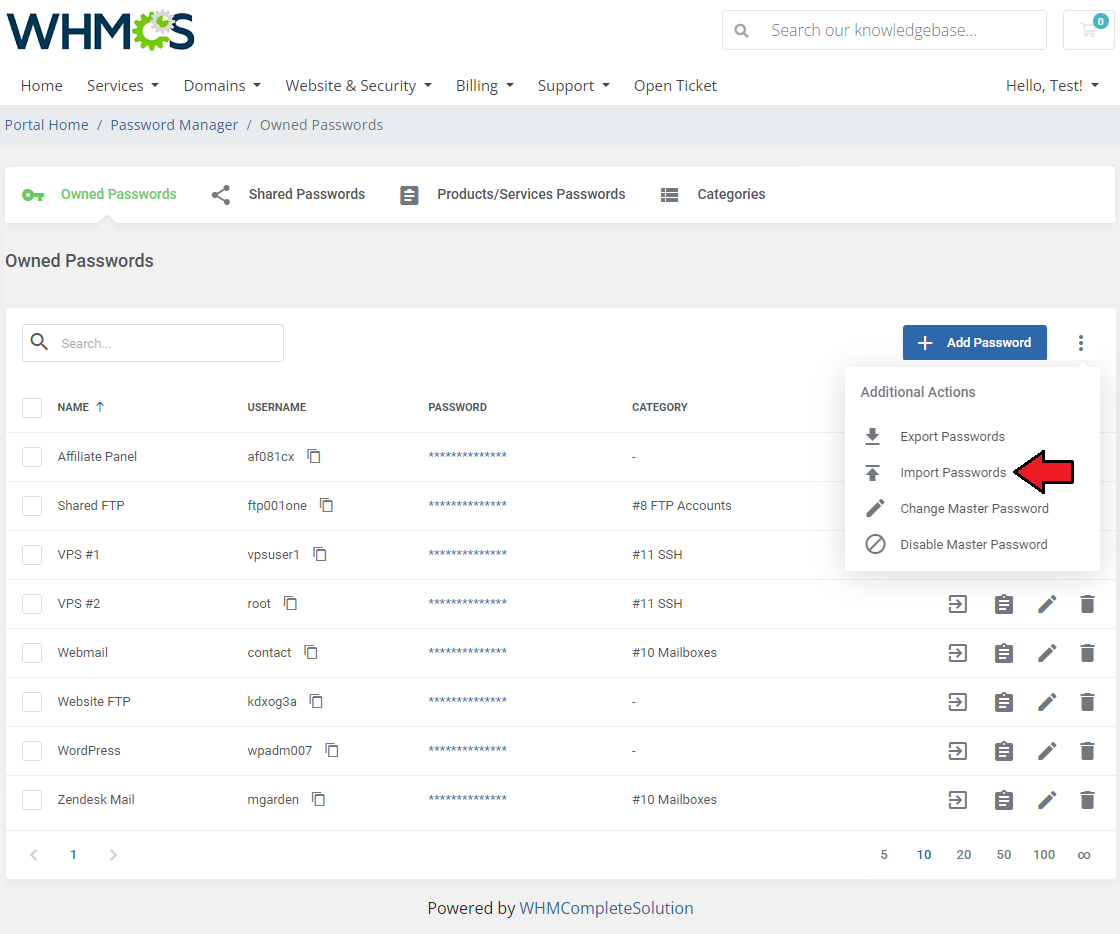
|
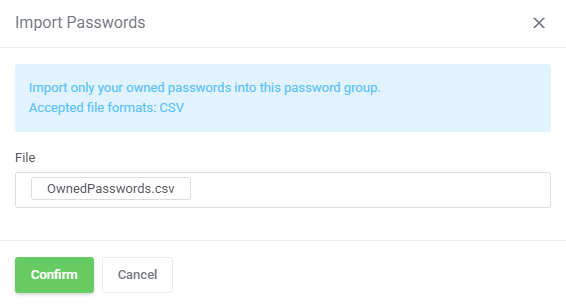
|
| Under 'Shared Passwords' your clients can view and manage access details that administrators shared with them, gave permission to view. |
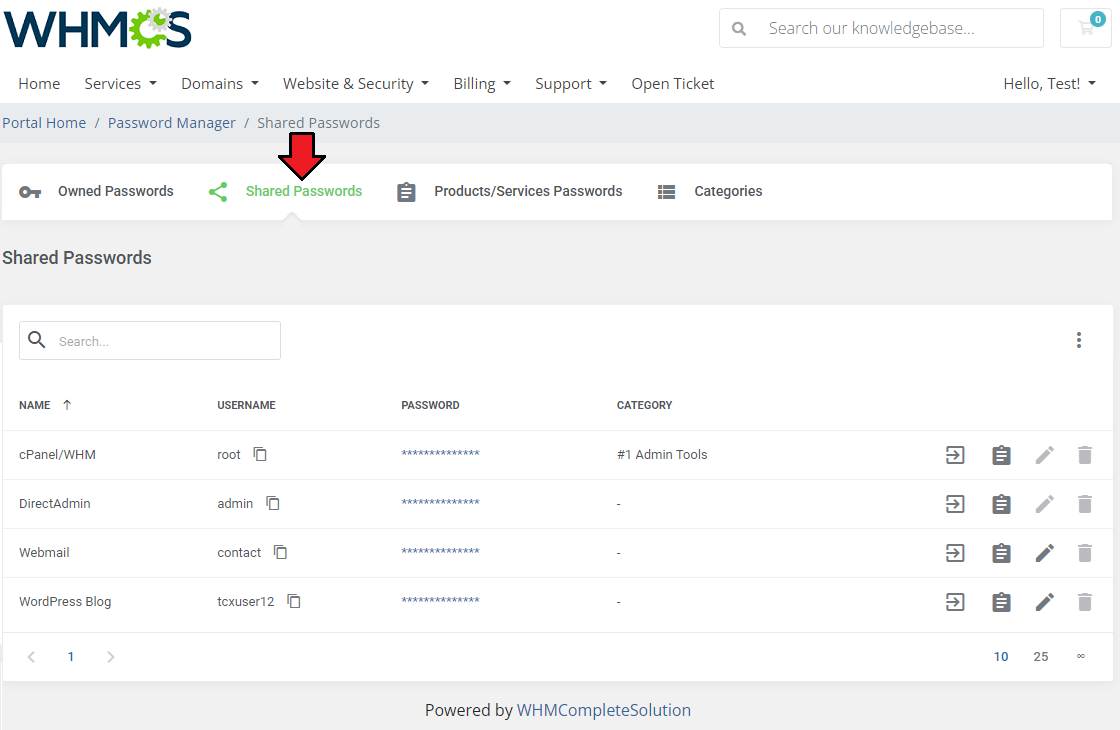
|
| Preview the password and use action buttons to manage the access details:
1. Log into the URL if it has been provided |
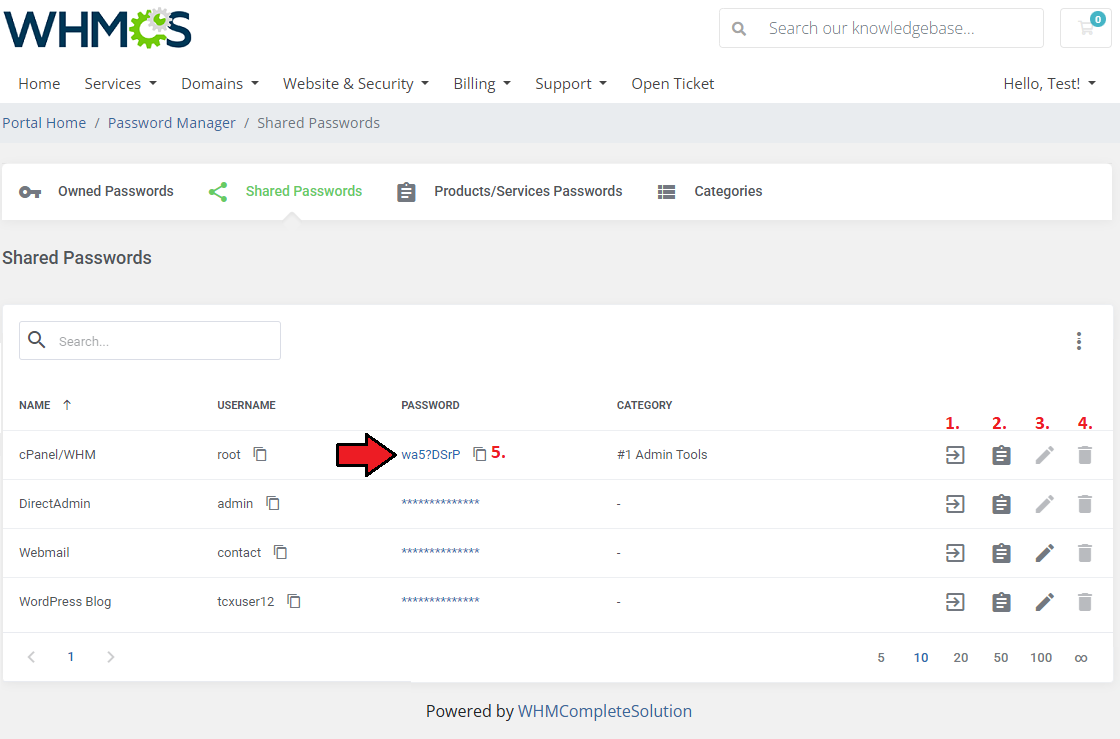
|
Product/Services Passwords
| 'Products/Services Passwords' section includes any access details to your client's products that they own. For convenience, clients can also assign additional passwords to selected services similarly like in 'Owned Passwords' section. Remember that as an administrator, you have to enable this option in the 'Addon' → 'Settings'→ 'Products/Services Passwords'. |
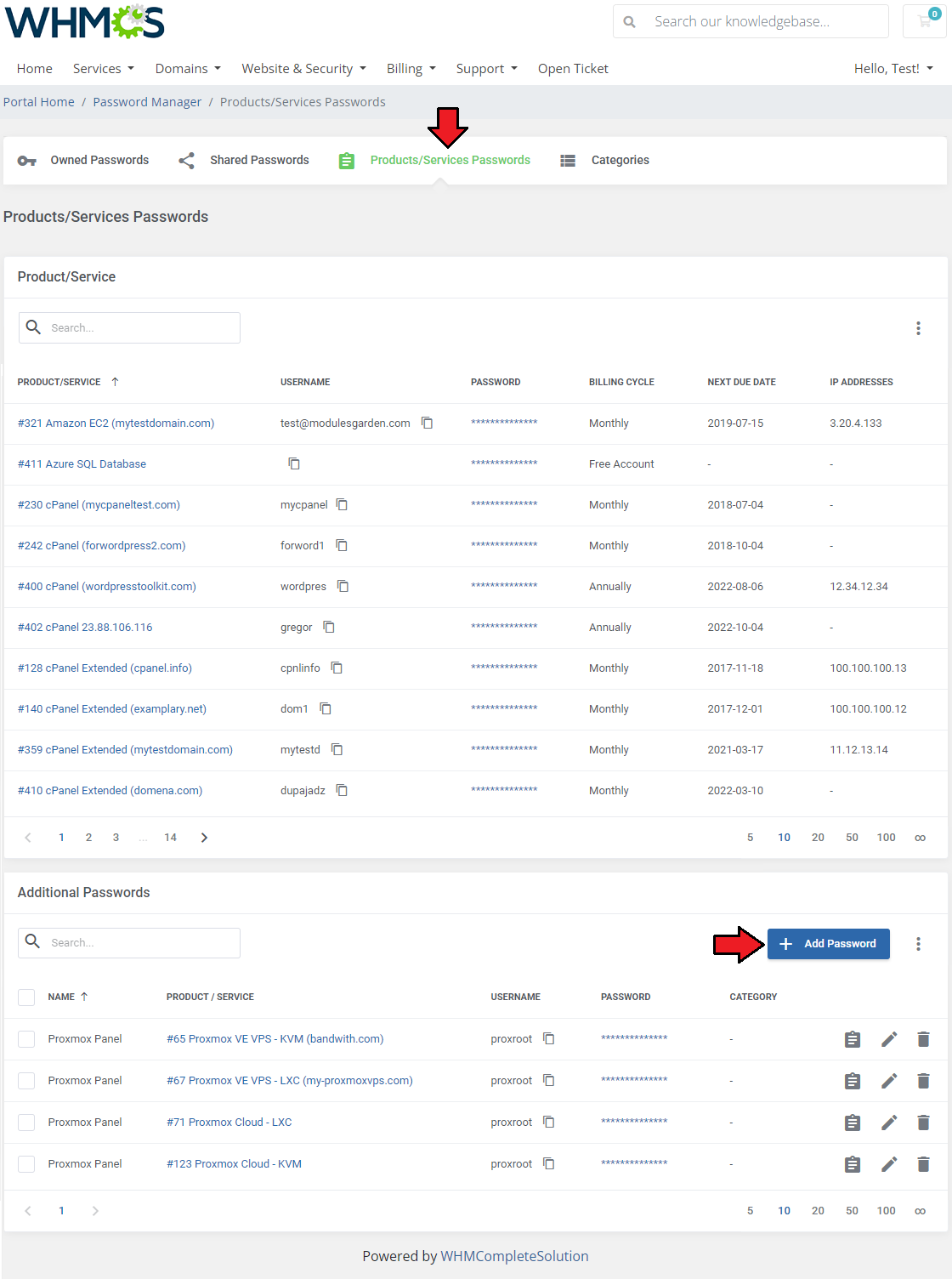
|
| Furthermore, you may export the passwords bundle into a file or, the other way round, import your passwords from a CSV file to the module. |
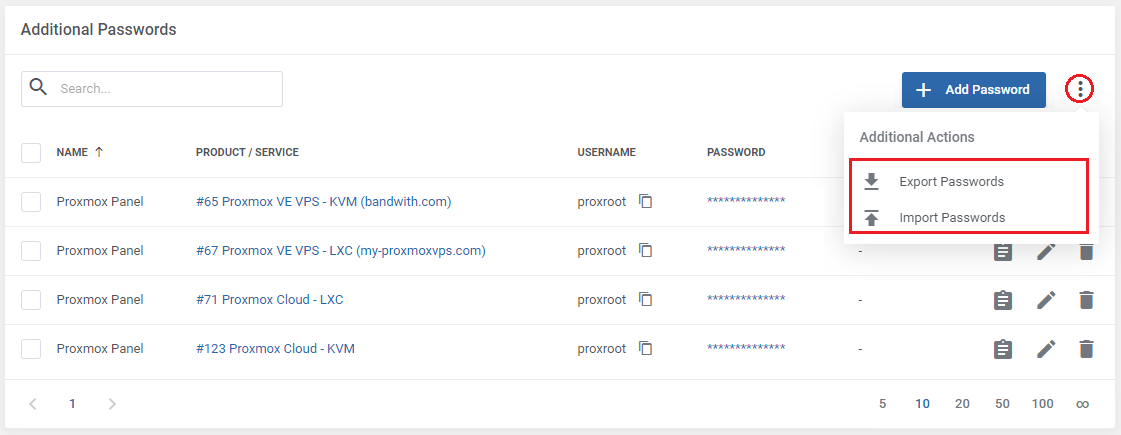
|
Categories
| Move to 'Categories' tab. There is a list of the created by the client categories which are used to allocate passwords for sharing. To create a new one, press the 'Add Category' button. |
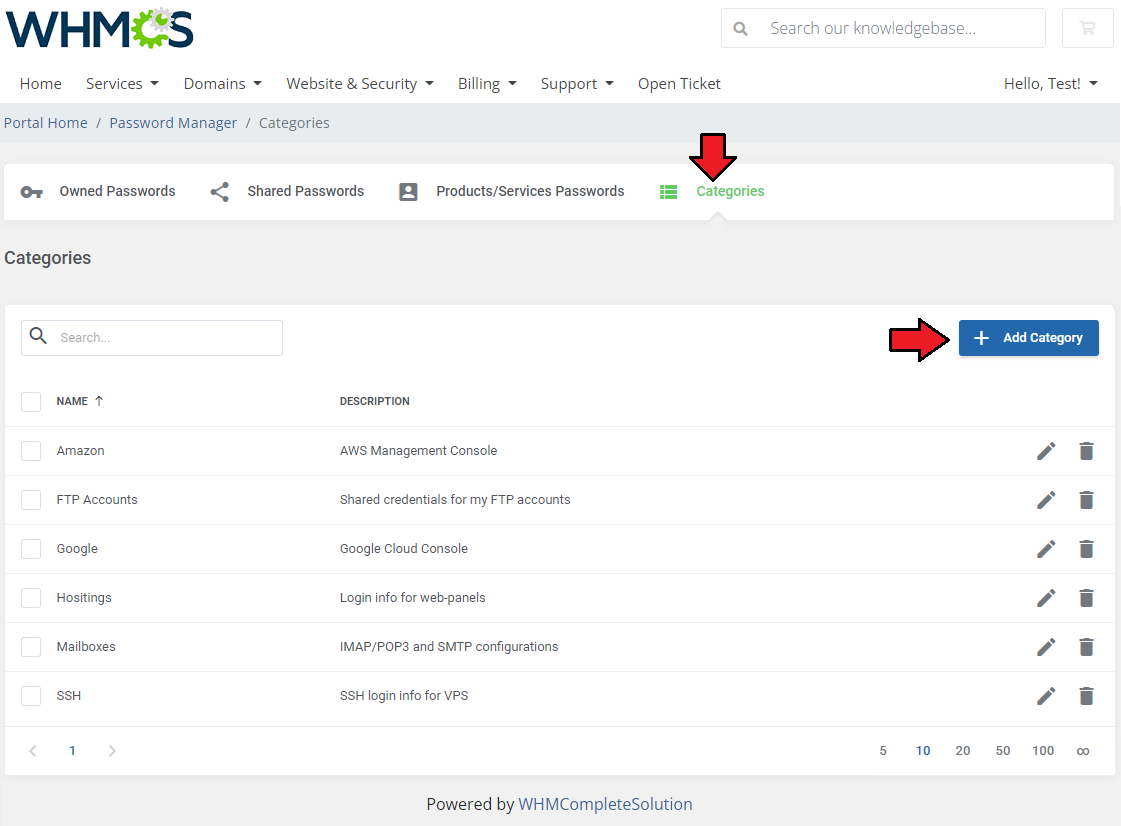
|
| Fill in category name and description and press 'Add'. Created category can be seen by this client as well as administrators in the administrator area. |
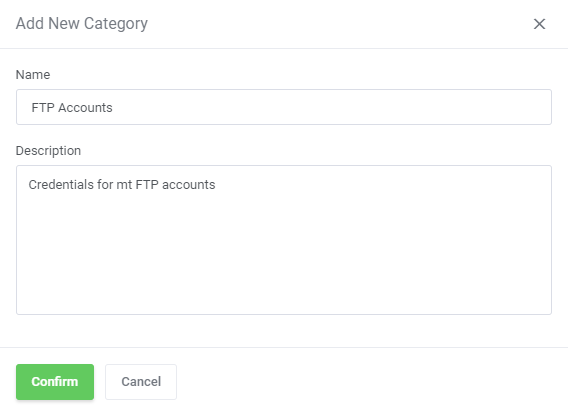
|
| Clients may edit their categories, and delete and add new ones any time they wish. |
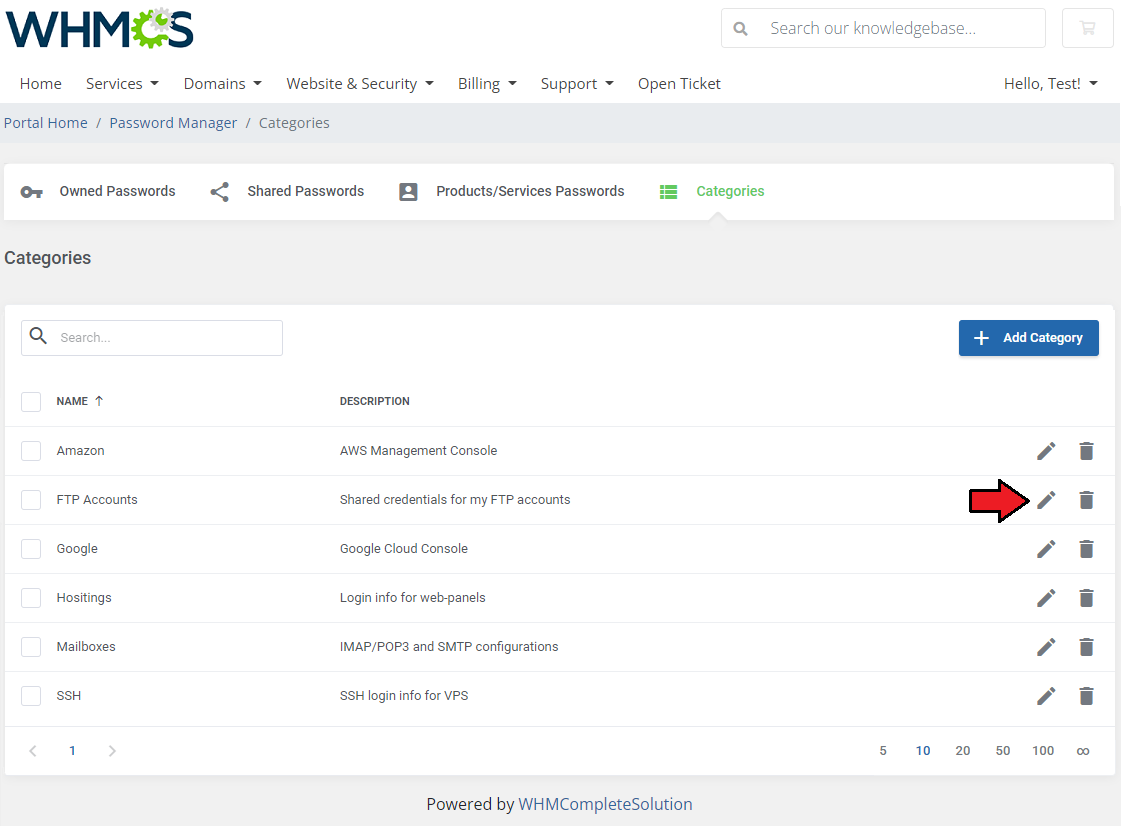
|
| Any categories created by clients will be automatically visible for administrators in the addon where you can manage them. |
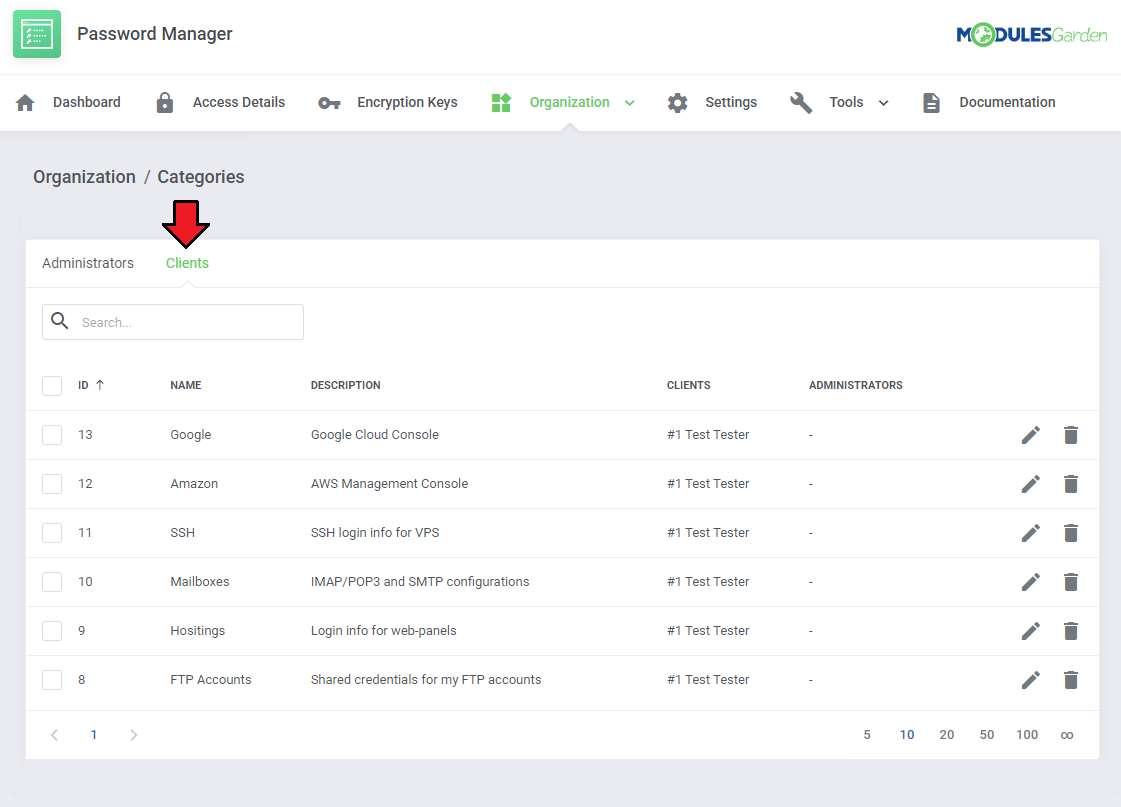
|
Tips
1. Any additional options under 'Addons' → 'Passwords Manager' → 'Settings' → 'Other' are by default enabled on the module activation.
|
2. Password Manager For WHMCS ensures full protection of your access details using its own security tools and WHMCS internal two-way encryption system.
|
| 3. As this module supports a templates system, any changes made in the module's templates files will be saved after the upgrade process. |
| 4. Password Manager For WHMCS module is a perfect solution for all resellers whose aim is to provide license keys to their clients in the most secure way possible. |
Update Instructions
| Essential guidance through the process of updating the module is offered here. Keep in mind there is a quick and easy option in our client area that will let you upgrade the license of your module to an open source version at any time - and at a lower price! |
Common Problems
| 1. When you have problems with connection, check whether your SELinux or firewall does not block ports. |